Schema
APSFR.xsd
element APSFR
complexType APSFR
attribute APSFR/@classificationCode
attribute APSFR/@creationDate
attribute APSFR/@creator
attribute APSFR/@description
attribute APSFR/@email
attribute APSFR/@generatedBy
attribute APSFR/@language
element APSFR/c_Cd
element APSFR/euuomCode
element APSFR/metaData
element APSFR/url
element APSFR/internationalUoM
element APSFR/MechanismsOfInternationalCoordination
element APSFR/SummaryInformation
element APSFR/AreasOfFloodRisk
complexType AreasOfFloodRisk
element AreasOfFloodRisk/apsfrCode
element AreasOfFloodRisk/crossBorderAPSFRCode
element AreasOfFloodRisk/crossBorderRelationship
element AreasOfFloodRisk/generalAdditionalComments
element AreasOfFloodRisk/lat
element AreasOfFloodRisk/lon
element AreasOfFloodRisk/nameOfAPSFR
element AreasOfFloodRisk/TypeOfFloods
element AreasOfFloodRisk/TypeofPotentialConsequences
complexType ConsiderationsOfConsequences
element ConsiderationsOfConsequences/considerationsHumanHealth
element ConsiderationsOfConsequences/considerationsEnvironment
element ConsiderationsOfConsequences/considerationsCulturalHeritage
element ConsiderationsOfConsequences/considerationsEconomicActivity
element ConsiderationsOfConsequences/methodologyReference
complexType CriteriaForDeterminationSignificantFloodRisk
element CriteriaForDeterminationSignificantFloodRisk/otherCriteriaDescription
element CriteriaForDeterminationSignificantFloodRisk/reference
element CriteriaForDeterminationSignificantFloodRisk/expertJudgementDescription
element CriteriaForDeterminationSignificantFloodRisk/criteriaUsed
complexType CriteriaForInclusion
element CriteriaForInclusion/criteriaUsed
element CriteriaForInclusion/otherCriteriaDescription
complexType CulturalHeritage
element CulturalHeritage/typeCulturalHeritage
element CulturalHeritage/otherConsequenceDescription
complexType EconomicActivity
element EconomicActivity/typeEconomicActivity
element EconomicActivity/otherConsequenceDescription
complexType Environment
element Environment/typeEnvironment
element Environment/otherConsequenceDescription
complexType HumanHealthSocial
element HumanHealthSocial/typeHumanHealth
element HumanHealthSocial/otherConsequenceDescription
complexType MechanismsOfInternationalCoordination
element MechanismsOfInternationalCoordination/mechanismsUsed
element MechanismsOfInternationalCoordination/otherMechanismsOfInternationalCoordination
element MechanismsOfInternationalCoordination/reference
complexType SummaryInformation
element SummaryInformation/overallApproachReviewReference
element SummaryInformation/ConsiderationsOfConsequences
element SummaryInformation/CriteriaForInclusion
element SummaryInformation/CriteriaForDeterminationSignificantFloodRisk
complexType TypeOfFloods
element TypeOfFloods/sourceOfFlooding
element TypeOfFloods/otherSource
element TypeOfFloods/sourceUncertainDescription
element TypeOfFloods/mechanismOfFlooding
element TypeOfFloods/otherMechanismDescription
element TypeOfFloods/mechanismUncertain
element TypeOfFloods/characteristicsOfFlooding
element TypeOfFloods/otherCharacteristicsDecsription
element TypeOfFloods/characteristicsUncertain
complexType TypeofPotentialConsequences
element TypeofPotentialConsequences/CulturalHeritage
element TypeofPotentialConsequences/EconomicActivity
element TypeofPotentialConsequences/Environment
element TypeofPotentialConsequences/HumanHealthSocial
complexType ReferenceType
element ReferenceType/Hyperlink
element ReferenceType/FileName
element ReferenceType/Bookmark
element ReferenceType/DocumentName
element ReferenceType/Subject
simpleType Article_6.6_Justification_Enum
simpleType Article_6.7_Justification_Enum
simpleType CategoryFloods_Enum
simpleType CharacteristicsofFlooding_Enum
simpleType ClimateChange_Enum
simpleType ConsultationStakeholdersInvolved_Enum
simpleType ConsultationStakeholdersInvolvedMechanisms_Enum
simpleType CoordinateType
simpleType CoordinationFRMPandRBMP_Enum
simpleType CountryCode_enum
simpleType CriteriaForDeterminationFloodRisk_Enum
simpleType CriteriaForExclusionOrInclusion_Enum
simpleType DataConfidentialityClassificationCode_Enum
simpleType DateTypeYearType
simpleType ElementsProbability_Enum
simpleType FeatureUniqueCodeType
simpleType FeatureUniqueCodeTypeEX
simpleType FeatureUniqueEUCodeType
simpleType FloodSourcesMapped_Enum
simpleType GeographicScale_Enum
simpleType HistorialSignificantFloodsCriteria_Enum
simpleType ImpactPublicParticipation_Enum
simpleType InternationalInformationExchange_Enum
simpleType IssuesArticle4.2.d_Enum
simpleType LanguageCode_Enum
simpleType LocalNationalInternationalCoordination_Enum
simpleType MeasureAspect_Enum
simpleType MeasureCodesProgress_Enum
simpleType MeasureType_Enum
simpleType MechanismofFlooding_Enum
simpleType MechanismsOfInternationalCoordination_Enum
simpleType NumberDecimalBaseType
simpleType NumberDecimalType
simpleType NumberExceptionType
simpleType NumberNonNegativeIntegerType
simpleType NumberPercentageBaseType
simpleType NumberPercentageType
simpleType PotentialAdverseConsequencesCriteria_Enum
simpleType PriorityCategories_Enum
simpleType ProtectedAreaType_Enum
simpleType PublicConsultationsMechanisms_Enum
simpleType RelavantSources_Enum
simpleType ReturnperiondandprobabiltiesApproach_Enum
simpleType SourceofFlooding_Enum
simpleType String1000Type
simpleType String100Type
simpleType String2000Type
simpleType String250Type
simpleType String5000Type
simpleType String50Type
simpleType TotalDamageClass_Enum
simpleType TypeCulturalHeritage_Enum
simpleType TypeEconomicActivity_Enum
simpleType TypeEnvironment_Enum
simpleType TypeHumanHealth_Enum
simpleType URLType
simpleType WiseDate
simpleType WiseDateTime
simpleType WiseDateTimeType
simpleType WiseEvolutionTypeValue
simpleType WiseLanguageCode_Enum
simpleType WiseYear
simpleType WiseYearMonth
simpleType YearMonthType
simpleType YesCode
simpleType YesNoCode
XML Schema documentation generated by XMLSpy Schema Editor http://www.altova.com/xmlspy
| schema location: | APSFR.xsd |
| attribute form default: | |
| element form default: | qualified |
| targetNamespace: | http://water.eionet.europa.eu/schemas/dir200760ec |
| schema location: | FDCommon.xsd |
| attribute form default: | |
| element form default: | qualified |
| targetNamespace: | http://water.eionet.europa.eu/schemas/dir200760ec/fdcommon |
element APSFR
| diagram |  |
||||||||||||||||||||||||||||||||||||||||||||||||||||||||||||||
| namespace | http://water.eionet.europa.eu/schemas/dir200760ec | ||||||||||||||||||||||||||||||||||||||||||||||||||||||||||||||
| type | APSFR | ||||||||||||||||||||||||||||||||||||||||||||||||||||||||||||||
| properties |
|
||||||||||||||||||||||||||||||||||||||||||||||||||||||||||||||
| children | c_Cd euuomCode metaData url internationalUoM MechanismsOfInternationalCoordination SummaryInformation AreasOfFloodRisk | ||||||||||||||||||||||||||||||||||||||||||||||||||||||||||||||
| attributes |
|
||||||||||||||||||||||||||||||||||||||||||||||||||||||||||||||
| source | <xs:element name="APSFR" type="APSFR"/> |
complexType APSFR
| diagram |  |
||||||||||||||||||||||||||||||||||||||||||||||||||||||||||||||
| namespace | http://water.eionet.europa.eu/schemas/dir200760ec | ||||||||||||||||||||||||||||||||||||||||||||||||||||||||||||||
| children | c_Cd euuomCode metaData url internationalUoM MechanismsOfInternationalCoordination SummaryInformation AreasOfFloodRisk | ||||||||||||||||||||||||||||||||||||||||||||||||||||||||||||||
| used by |
|
||||||||||||||||||||||||||||||||||||||||||||||||||||||||||||||
| attributes |
|
||||||||||||||||||||||||||||||||||||||||||||||||||||||||||||||
| annotation |
|
||||||||||||||||||||||||||||||||||||||||||||||||||||||||||||||
| source | <xs:complexType name="APSFR"> <xs:annotation> <xs:documentation>Required.</xs:documentation> </xs:annotation> <xs:sequence> <xs:element name="c_Cd" type="fd:CountryCode_enum"> <xs:annotation> <xs:documentation>Required. Two-letter ISO Country code. Select relevant code from enumeration list provided.</xs:documentation> </xs:annotation> </xs:element> <xs:element name="euuomCode" type="fd:FeatureUniqueEUCodeType"> <xs:annotation> <xs:documentation>Required. Unique EU code for the Unit of Management. Add the two-letter ISO Country code to the Member State unique id - up to 42 characters in total</xs:documentation> </xs:annotation> </xs:element> <xs:element name="metaData" type="fd:String2000Type" minOccurs="0"> <xs:annotation> <xs:documentation>Optional. Hyperlink or reference to associated metadata statement or file. This allows up to 2000 characters to be specified or alternatively may be used to provide a hyperlink or description of an associated metadata file. This should be used to define any restrictions on the data</xs:documentation> </xs:annotation> </xs:element> <xs:element name="url" type="xs:anyURI" minOccurs="0"> <xs:annotation> <xs:documentation>Optional. URL for integration of your own internet-based information</xs:documentation> </xs:annotation> </xs:element> <xs:element name="internationalUoM" type="fd:YesNoCode"> <xs:annotation> <xs:documentation>Required. Is the UoM international? - Yes - No If ‘Yes’, please provide the information requested in the schema elements below relating to mechanisms of coordination.</xs:documentation> </xs:annotation> </xs:element> <xs:element name="MechanismsOfInternationalCoordination" type="MechanismsOfInternationalCoordination" minOccurs="0"/> <xs:element name="SummaryInformation" type="SummaryInformation"/> <xs:element name="AreasOfFloodRisk" type="AreasOfFloodRisk"/> </xs:sequence> <xs:attribute name="classificationCode" type="fd:DataConfidentialityClassificationCode_Enum" use="optional"> <xs:annotation> <xs:documentation>Optional. Codes for data security classification: - 001 – Unclassified – available for general circulation and public - 003 – Confidential – available for EC reporting only </xs:documentation> </xs:annotation> </xs:attribute> <xs:attribute name="creationDate" type="xs:string" use="optional"> <xs:annotation> <xs:documentation>Required. To be provided as year, month, date (e.g. “2012-03-20”)</xs:documentation> </xs:annotation> </xs:attribute> <xs:attribute name="creator" type="xs:string" use="optional"> <xs:annotation> <xs:documentation>Required. Competent Authority responsible for providing the information (e.g. “SEPA” (Scottish Environmental Protection Agency))</xs:documentation> </xs:annotation> </xs:attribute> <xs:attribute name="description" type="xs:string" use="optional"> <xs:annotation> <xs:documentation>Optional. For example: “Floods Directive APSFR Information”</xs:documentation> </xs:annotation> </xs:attribute> <xs:attribute name="email" type="xs:string" use="optional"> <xs:annotation> <xs:documentation>Optional. For example “frmplanning@sepa.org.uk”</xs:documentation> </xs:annotation> </xs:attribute> <xs:attribute name="generatedBy" type="xs:string" use="optional"> <xs:annotation> <xs:documentation>Optional. For example “Oracle scripts”</xs:documentation> </xs:annotation> </xs:attribute> <xs:attribute name="language" type="fd:LanguageCode_Enum" use="optional"> <xs:annotation> <xs:documentation>Required. Two-letter ISO Country code. Select relevant code from enumeration list provided.</xs:documentation> </xs:annotation> </xs:attribute> </xs:complexType> |
attribute APSFR/@classificationCode
| type | DataConfidentialityClassificationCode_Enum | |||||||||
| properties |
|
|||||||||
| facets |
|
|||||||||
| annotation |
|
|||||||||
| source | <xs:attribute name="classificationCode" type="fd:DataConfidentialityClassificationCode_Enum" use="optional"> <xs:annotation> <xs:documentation>Optional. Codes for data security classification: - 001 – Unclassified – available for general circulation and public - 003 – Confidential – available for EC reporting only </xs:documentation> </xs:annotation> </xs:attribute> |
attribute APSFR/@creationDate
| type | xs:string | ||||
| properties |
|
||||
| annotation |
|
||||
| source | <xs:attribute name="creationDate" type="xs:string" use="optional"> <xs:annotation> <xs:documentation>Required. To be provided as year, month, date (e.g. “2012-03-20”)</xs:documentation> </xs:annotation> </xs:attribute> |
attribute APSFR/@creator
| type | xs:string | ||||
| properties |
|
||||
| annotation |
|
||||
| source | <xs:attribute name="creator" type="xs:string" use="optional"> <xs:annotation> <xs:documentation>Required. Competent Authority responsible for providing the information (e.g. “SEPA” (Scottish Environmental Protection Agency))</xs:documentation> </xs:annotation> </xs:attribute> |
attribute APSFR/@description
| type | xs:string | ||||
| properties |
|
||||
| annotation |
|
||||
| source | <xs:attribute name="description" type="xs:string" use="optional"> <xs:annotation> <xs:documentation>Optional. For example: “Floods Directive APSFR Information”</xs:documentation> </xs:annotation> </xs:attribute> |
attribute APSFR/@email
| type | xs:string | ||||
| properties |
|
||||
| annotation |
|
||||
| source | <xs:attribute name="email" type="xs:string" use="optional"> <xs:annotation> <xs:documentation>Optional. For example “frmplanning@sepa.org.uk”</xs:documentation> </xs:annotation> </xs:attribute> |
attribute APSFR/@generatedBy
| type | xs:string | ||||
| properties |
|
||||
| annotation |
|
||||
| source | <xs:attribute name="generatedBy" type="xs:string" use="optional"> <xs:annotation> <xs:documentation>Optional. For example “Oracle scripts”</xs:documentation> </xs:annotation> </xs:attribute> |
attribute APSFR/@language
| type | LanguageCode_Enum | |||||||||||||||||||||||||||||||||||||||||||||||||||||||||||||||||||||||||||||||||||||||
| properties |
|
|||||||||||||||||||||||||||||||||||||||||||||||||||||||||||||||||||||||||||||||||||||||
| facets |
|
|||||||||||||||||||||||||||||||||||||||||||||||||||||||||||||||||||||||||||||||||||||||
| annotation |
|
|||||||||||||||||||||||||||||||||||||||||||||||||||||||||||||||||||||||||||||||||||||||
| source | <xs:attribute name="language" type="fd:LanguageCode_Enum" use="optional"> <xs:annotation> <xs:documentation>Required. Two-letter ISO Country code. Select relevant code from enumeration list provided.</xs:documentation> </xs:annotation> </xs:attribute> |
element APSFR/c_Cd
| diagram |  |
|||||||||||||||||||||||||||||||||||||||||||||||||||||||||||||||||||||||||||||||||||||||||||||||||||
| namespace | http://water.eionet.europa.eu/schemas/dir200760ec | |||||||||||||||||||||||||||||||||||||||||||||||||||||||||||||||||||||||||||||||||||||||||||||||||||
| type | CountryCode_enum | |||||||||||||||||||||||||||||||||||||||||||||||||||||||||||||||||||||||||||||||||||||||||||||||||||
| properties |
|
|||||||||||||||||||||||||||||||||||||||||||||||||||||||||||||||||||||||||||||||||||||||||||||||||||
| facets |
|
|||||||||||||||||||||||||||||||||||||||||||||||||||||||||||||||||||||||||||||||||||||||||||||||||||
| annotation |
|
|||||||||||||||||||||||||||||||||||||||||||||||||||||||||||||||||||||||||||||||||||||||||||||||||||
| source | <xs:element name="c_Cd" type="fd:CountryCode_enum"> <xs:annotation> <xs:documentation>Required. Two-letter ISO Country code. Select relevant code from enumeration list provided.</xs:documentation> </xs:annotation> </xs:element> |
element APSFR/euuomCode
| diagram | 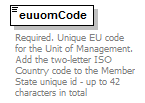 |
|||||||||
| namespace | http://water.eionet.europa.eu/schemas/dir200760ec | |||||||||
| type | FeatureUniqueEUCodeType | |||||||||
| properties |
|
|||||||||
| facets |
|
|||||||||
| annotation |
|
|||||||||
| source | <xs:element name="euuomCode" type="fd:FeatureUniqueEUCodeType"> <xs:annotation> <xs:documentation>Required. Unique EU code for the Unit of Management. Add the two-letter ISO Country code to the Member State unique id - up to 42 characters in total</xs:documentation> </xs:annotation> </xs:element> |
element APSFR/metaData
| diagram | 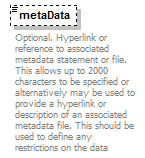 |
|||||||||
| namespace | http://water.eionet.europa.eu/schemas/dir200760ec | |||||||||
| type | String2000Type | |||||||||
| properties |
|
|||||||||
| facets |
|
|||||||||
| annotation |
|
|||||||||
| source | <xs:element name="metaData" type="fd:String2000Type" minOccurs="0"> <xs:annotation> <xs:documentation>Optional. Hyperlink or reference to associated metadata statement or file. This allows up to 2000 characters to be specified or alternatively may be used to provide a hyperlink or description of an associated metadata file. This should be used to define any restrictions on the data</xs:documentation> </xs:annotation> </xs:element> |
element APSFR/url
| diagram |  |
||||||||
| namespace | http://water.eionet.europa.eu/schemas/dir200760ec | ||||||||
| type | xs:anyURI | ||||||||
| properties |
|
||||||||
| annotation |
|
||||||||
| source | <xs:element name="url" type="xs:anyURI" minOccurs="0"> <xs:annotation> <xs:documentation>Optional. URL for integration of your own internet-based information</xs:documentation> </xs:annotation> </xs:element> |
element APSFR/internationalUoM
| diagram | 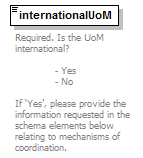 |
||||||||||||
| namespace | http://water.eionet.europa.eu/schemas/dir200760ec | ||||||||||||
| type | YesNoCode | ||||||||||||
| properties |
|
||||||||||||
| facets |
|
||||||||||||
| annotation |
|
||||||||||||
| source | <xs:element name="internationalUoM" type="fd:YesNoCode"> <xs:annotation> <xs:documentation>Required. Is the UoM international? - Yes - No If ‘Yes’, please provide the information requested in the schema elements below relating to mechanisms of coordination.</xs:documentation> </xs:annotation> </xs:element> |
element APSFR/MechanismsOfInternationalCoordination
| diagram | 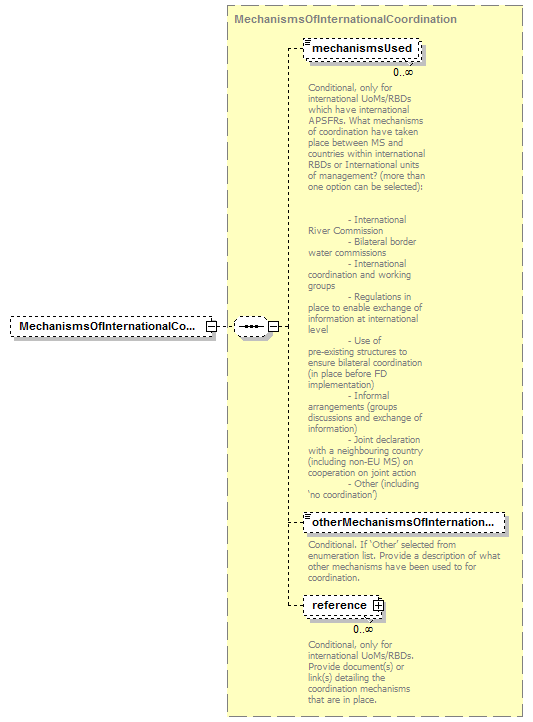 |
||||||||
| namespace | http://water.eionet.europa.eu/schemas/dir200760ec | ||||||||
| type | MechanismsOfInternationalCoordination | ||||||||
| properties |
|
||||||||
| children | mechanismsUsed otherMechanismsOfInternationalCoordination reference | ||||||||
| source | <xs:element name="MechanismsOfInternationalCoordination" type="MechanismsOfInternationalCoordination" minOccurs="0"/> |
element APSFR/SummaryInformation
| diagram | 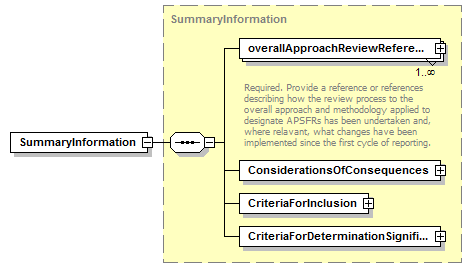 |
||||
| namespace | http://water.eionet.europa.eu/schemas/dir200760ec | ||||
| type | SummaryInformation | ||||
| properties |
|
||||
| children | overallApproachReviewReference ConsiderationsOfConsequences CriteriaForInclusion CriteriaForDeterminationSignificantFloodRisk | ||||
| source | <xs:element name="SummaryInformation" type="SummaryInformation"/> |
element APSFR/AreasOfFloodRisk
| diagram | 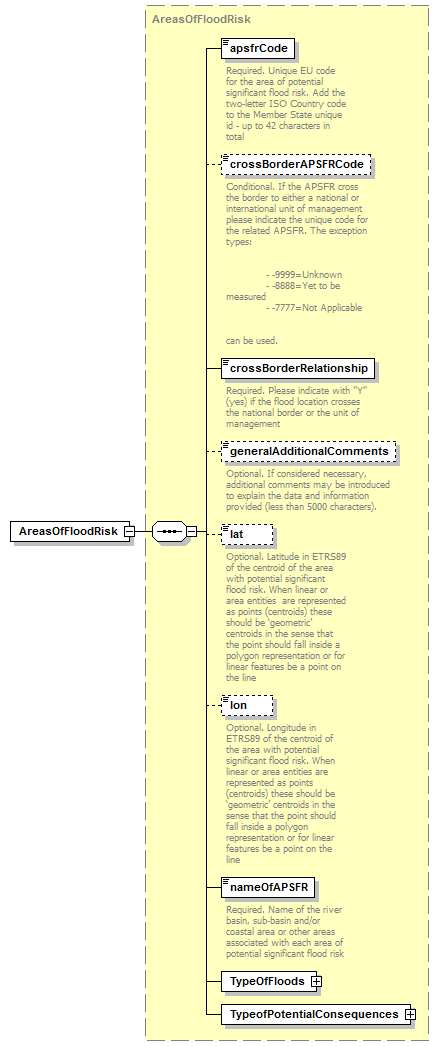 |
||||
| namespace | http://water.eionet.europa.eu/schemas/dir200760ec | ||||
| type | AreasOfFloodRisk | ||||
| properties |
|
||||
| children | apsfrCode crossBorderAPSFRCode crossBorderRelationship generalAdditionalComments lat lon nameOfAPSFR TypeOfFloods TypeofPotentialConsequences | ||||
| source | <xs:element name="AreasOfFloodRisk" type="AreasOfFloodRisk"/> |
complexType AreasOfFloodRisk
| diagram | 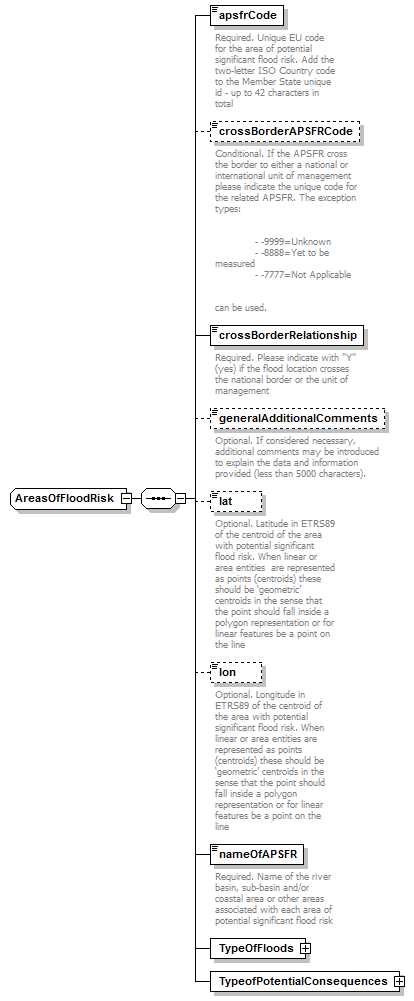 |
||
| namespace | http://water.eionet.europa.eu/schemas/dir200760ec | ||
| children | apsfrCode crossBorderAPSFRCode crossBorderRelationship generalAdditionalComments lat lon nameOfAPSFR TypeOfFloods TypeofPotentialConsequences | ||
| used by |
|
||
| source | <xs:complexType name="AreasOfFloodRisk"> <xs:sequence> <xs:element name="apsfrCode" type="fd:FeatureUniqueEUCodeType"> <xs:annotation> <xs:documentation>Required. Unique EU code for the area of potential significant flood risk. Add the two-letter ISO Country code to the Member State unique id - up to 42 characters in total</xs:documentation> </xs:annotation> </xs:element> <xs:element name="crossBorderAPSFRCode" type="fd:FeatureUniqueCodeTypeEX" minOccurs="0"> <xs:annotation> <xs:documentation>Conditional. If the APSFR cross the border to either a national or international unit of management please indicate the unique code for the related APSFR. The exception types: - -9999=Unknown - -8888=Yet to be measured - -7777=Not Applicable can be used.</xs:documentation> </xs:annotation> </xs:element> <xs:element name="crossBorderRelationship" type="fd:YesNoCode"> <xs:annotation> <xs:documentation>Required. Please indicate with "Y" (yes) if the flood location crosses the national border or the unit of management</xs:documentation> </xs:annotation> </xs:element> <xs:element name="generalAdditionalComments" type="fd:String5000Type" minOccurs="0"> <xs:annotation> <xs:documentation>Optional. If considered necessary, additional comments may be introduced to explain the data and information provided (less than 5000 characters).</xs:documentation> </xs:annotation> </xs:element> <xs:element name="lat" type="fd:CoordinateType" minOccurs="0"> <xs:annotation> <xs:documentation>Optional. Latitude in ETRS89 of the centroid of the area with potential significant flood risk. When linear or area entities are represented as points (centroids) these should be ‘geometric’ centroids in the sense that the point should fall inside a polygon representation or for linear features be a point on the line</xs:documentation> </xs:annotation> </xs:element> <xs:element name="lon" type="fd:CoordinateType" minOccurs="0"> <xs:annotation> <xs:documentation>Optional. Longitude in ETRS89 of the centroid of the area with potential significant flood risk. When linear or area entities are represented as points (centroids) these should be ‘geometric’ centroids in the sense that the point should fall inside a polygon representation or for linear features be a point on the line</xs:documentation> </xs:annotation> </xs:element> <xs:element name="nameOfAPSFR" type="fd:String250Type"> <xs:annotation> <xs:documentation>Required. Name of the river basin, sub-basin and/or coastal area or other areas associated with each area of potential significant flood risk</xs:documentation> </xs:annotation> </xs:element> <xs:element name="TypeOfFloods" type="TypeOfFloods"/> <xs:element name="TypeofPotentialConsequences" type="TypeofPotentialConsequences"/> </xs:sequence> </xs:complexType> |
element AreasOfFloodRisk/apsfrCode
| diagram | 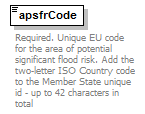 |
|||||||||
| namespace | http://water.eionet.europa.eu/schemas/dir200760ec | |||||||||
| type | FeatureUniqueEUCodeType | |||||||||
| properties |
|
|||||||||
| facets |
|
|||||||||
| annotation |
|
|||||||||
| source | <xs:element name="apsfrCode" type="fd:FeatureUniqueEUCodeType"> <xs:annotation> <xs:documentation>Required. Unique EU code for the area of potential significant flood risk. Add the two-letter ISO Country code to the Member State unique id - up to 42 characters in total</xs:documentation> </xs:annotation> </xs:element> |
element AreasOfFloodRisk/crossBorderAPSFRCode
| diagram | 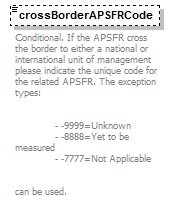 |
||||||||
| namespace | http://water.eionet.europa.eu/schemas/dir200760ec | ||||||||
| type | FeatureUniqueCodeTypeEX | ||||||||
| properties |
|
||||||||
| annotation |
|
||||||||
| source | <xs:element name="crossBorderAPSFRCode" type="fd:FeatureUniqueCodeTypeEX" minOccurs="0"> <xs:annotation> <xs:documentation>Conditional. If the APSFR cross the border to either a national or international unit of management please indicate the unique code for the related APSFR. The exception types: - -9999=Unknown - -8888=Yet to be measured - -7777=Not Applicable can be used.</xs:documentation> </xs:annotation> </xs:element> |
element AreasOfFloodRisk/crossBorderRelationship
| diagram |  |
||||||||||||
| namespace | http://water.eionet.europa.eu/schemas/dir200760ec | ||||||||||||
| type | YesNoCode | ||||||||||||
| properties |
|
||||||||||||
| facets |
|
||||||||||||
| annotation |
|
||||||||||||
| source | <xs:element name="crossBorderRelationship" type="fd:YesNoCode"> <xs:annotation> <xs:documentation>Required. Please indicate with "Y" (yes) if the flood location crosses the national border or the unit of management</xs:documentation> </xs:annotation> </xs:element> |
element AreasOfFloodRisk/generalAdditionalComments
| diagram |  |
|||||||||
| namespace | http://water.eionet.europa.eu/schemas/dir200760ec | |||||||||
| type | String5000Type | |||||||||
| properties |
|
|||||||||
| facets |
|
|||||||||
| annotation |
|
|||||||||
| source | <xs:element name="generalAdditionalComments" type="fd:String5000Type" minOccurs="0"> <xs:annotation> <xs:documentation>Optional. If considered necessary, additional comments may be introduced to explain the data and information provided (less than 5000 characters).</xs:documentation> </xs:annotation> </xs:element> |
element AreasOfFloodRisk/lat
| diagram | 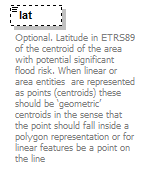 |
||||||||
| namespace | http://water.eionet.europa.eu/schemas/dir200760ec | ||||||||
| type | CoordinateType | ||||||||
| properties |
|
||||||||
| facets |
|
||||||||
| annotation |
|
||||||||
| source | <xs:element name="lat" type="fd:CoordinateType" minOccurs="0"> <xs:annotation> <xs:documentation>Optional. Latitude in ETRS89 of the centroid of the area with potential significant flood risk. When linear or area entities are represented as points (centroids) these should be ‘geometric’ centroids in the sense that the point should fall inside a polygon representation or for linear features be a point on the line</xs:documentation> </xs:annotation> </xs:element> |
element AreasOfFloodRisk/lon
| diagram | 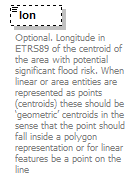 |
||||||||
| namespace | http://water.eionet.europa.eu/schemas/dir200760ec | ||||||||
| type | CoordinateType | ||||||||
| properties |
|
||||||||
| facets |
|
||||||||
| annotation |
|
||||||||
| source | <xs:element name="lon" type="fd:CoordinateType" minOccurs="0"> <xs:annotation> <xs:documentation>Optional. Longitude in ETRS89 of the centroid of the area with potential significant flood risk. When linear or area entities are represented as points (centroids) these should be ‘geometric’ centroids in the sense that the point should fall inside a polygon representation or for linear features be a point on the line</xs:documentation> </xs:annotation> </xs:element> |
element AreasOfFloodRisk/nameOfAPSFR
| diagram |  |
|||||||||
| namespace | http://water.eionet.europa.eu/schemas/dir200760ec | |||||||||
| type | String250Type | |||||||||
| properties |
|
|||||||||
| facets |
|
|||||||||
| annotation |
|
|||||||||
| source | <xs:element name="nameOfAPSFR" type="fd:String250Type"> <xs:annotation> <xs:documentation>Required. Name of the river basin, sub-basin and/or coastal area or other areas associated with each area of potential significant flood risk</xs:documentation> </xs:annotation> </xs:element> |
element AreasOfFloodRisk/TypeOfFloods
| diagram |  |
||||
| namespace | http://water.eionet.europa.eu/schemas/dir200760ec | ||||
| type | TypeOfFloods | ||||
| properties |
|
||||
| children | sourceOfFlooding otherSource sourceUncertainDescription mechanismOfFlooding otherMechanismDescription mechanismUncertain characteristicsOfFlooding otherCharacteristicsDecsription characteristicsUncertain | ||||
| source | <xs:element name="TypeOfFloods" type="TypeOfFloods"/> |
element AreasOfFloodRisk/TypeofPotentialConsequences
| diagram | 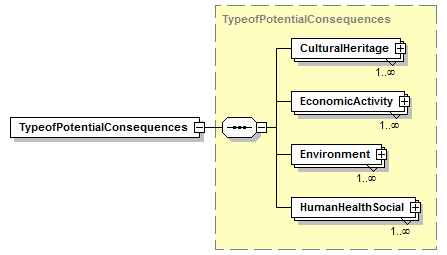 |
||||
| namespace | http://water.eionet.europa.eu/schemas/dir200760ec | ||||
| type | TypeofPotentialConsequences | ||||
| properties |
|
||||
| children | CulturalHeritage EconomicActivity Environment HumanHealthSocial | ||||
| source | <xs:element name="TypeofPotentialConsequences" type="TypeofPotentialConsequences"/> |
complexType ConsiderationsOfConsequences
| diagram | 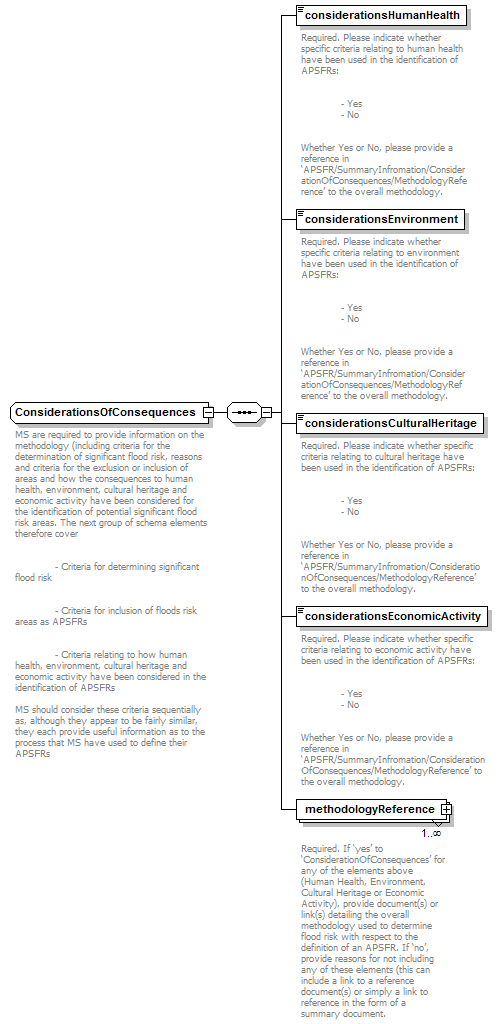 |
||
| namespace | http://water.eionet.europa.eu/schemas/dir200760ec | ||
| children | considerationsHumanHealth considerationsEnvironment considerationsCulturalHeritage considerationsEconomicActivity methodologyReference | ||
| used by |
|
||
| annotation |
|
||
| source | <xs:complexType name="ConsiderationsOfConsequences"> <xs:annotation> <xs:documentation>MS are required to provide information on the methodology (including criteria for the determination of significant flood risk, reasons and criteria for the exclusion or inclusion of areas and how the consequences to human health, environment, cultural heritage and economic activity have been considered for the identification of potential significant flood risk areas. The next group of schema elements therefore cover - Criteria for determining significant flood risk - Criteria for inclusion of floods risk areas as APSFRs - Criteria relating to how human health, environment, cultural heritage and economic activity have been considered in the identification of APSFRs MS should consider these criteria sequentially as, although they appear to be fairly similar, they each provide useful information as to the process that MS have used to define their APSFRs</xs:documentation> </xs:annotation> <xs:sequence> <xs:element name="considerationsHumanHealth" type="fd:YesNoCode"> <xs:annotation> <xs:documentation>Required. Please indicate whether specific criteria relating to human health have been used in the identification of APSFRs: - Yes - No Whether Yes or No, please provide a reference in ‘APSFR/SummaryInfromation/ConsiderationOfConsequences/MethodologyReference’ to the overall methodology.</xs:documentation> </xs:annotation> </xs:element> <xs:element name="considerationsEnvironment" type="fd:YesNoCode"> <xs:annotation> <xs:documentation>Required. Please indicate whether specific criteria relating to environment have been used in the identification of APSFRs: - Yes - No Whether Yes or No, please provide a reference in ‘APSFR/SummaryInfromation/ConsiderationOfConsequences/MethodologyReference’ to the overall methodology.</xs:documentation> </xs:annotation> </xs:element> <xs:element name="considerationsCulturalHeritage" type="fd:YesNoCode"> <xs:annotation> <xs:documentation>Required. Please indicate whether specific criteria relating to cultural heritage have been used in the identification of APSFRs: - Yes - No Whether Yes or No, please provide a reference in ‘APSFR/SummaryInfromation/ConsiderationOfConsequences/MethodologyReference’ to the overall methodology.</xs:documentation> </xs:annotation> </xs:element> <xs:element name="considerationsEconomicActivity" type="fd:YesNoCode"> <xs:annotation> <xs:documentation>Required. Please indicate whether specific criteria relating to economic activity have been used in the identification of APSFRs: - Yes - No Whether Yes or No, please provide a reference in ‘APSFR/SummaryInfromation/ConsiderationOfConsequences/MethodologyReference’ to the overall methodology.</xs:documentation> </xs:annotation> </xs:element> <xs:element name="methodologyReference" type="fd:ReferenceType" maxOccurs="unbounded"> <xs:annotation> <xs:documentation>Required. If ‘yes’ to ‘ConsiderationOfConsequences’ for any of the elements above (Human Health, Environment, Cultural Heritage or Economic Activity), provide document(s) or link(s) detailing the overall methodology used to determine flood risk with respect to the definition of an APSFR. If ‘no’, provide reasons for not including any of these elements (this can include a link to a reference document(s) or simply a link to reference in the form of a summary document.</xs:documentation> </xs:annotation> </xs:element> </xs:sequence> </xs:complexType> |
element ConsiderationsOfConsequences/considerationsHumanHealth
| diagram | 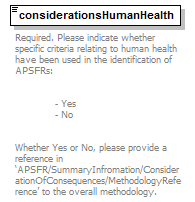 |
||||||||||||
| namespace | http://water.eionet.europa.eu/schemas/dir200760ec | ||||||||||||
| type | YesNoCode | ||||||||||||
| properties |
|
||||||||||||
| facets |
|
||||||||||||
| annotation |
|
||||||||||||
| source | <xs:element name="considerationsHumanHealth" type="fd:YesNoCode"> <xs:annotation> <xs:documentation>Required. Please indicate whether specific criteria relating to human health have been used in the identification of APSFRs: - Yes - No Whether Yes or No, please provide a reference in ‘APSFR/SummaryInfromation/ConsiderationOfConsequences/MethodologyReference’ to the overall methodology.</xs:documentation> </xs:annotation> </xs:element> |
element ConsiderationsOfConsequences/considerationsEnvironment
| diagram | 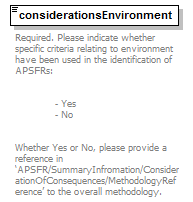 |
||||||||||||
| namespace | http://water.eionet.europa.eu/schemas/dir200760ec | ||||||||||||
| type | YesNoCode | ||||||||||||
| properties |
|
||||||||||||
| facets |
|
||||||||||||
| annotation |
|
||||||||||||
| source | <xs:element name="considerationsEnvironment" type="fd:YesNoCode"> <xs:annotation> <xs:documentation>Required. Please indicate whether specific criteria relating to environment have been used in the identification of APSFRs: - Yes - No Whether Yes or No, please provide a reference in ‘APSFR/SummaryInfromation/ConsiderationOfConsequences/MethodologyReference’ to the overall methodology.</xs:documentation> </xs:annotation> </xs:element> |
element ConsiderationsOfConsequences/considerationsCulturalHeritage
| diagram | 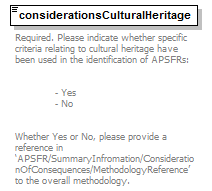 |
||||||||||||
| namespace | http://water.eionet.europa.eu/schemas/dir200760ec | ||||||||||||
| type | YesNoCode | ||||||||||||
| properties |
|
||||||||||||
| facets |
|
||||||||||||
| annotation |
|
||||||||||||
| source | <xs:element name="considerationsCulturalHeritage" type="fd:YesNoCode"> <xs:annotation> <xs:documentation>Required. Please indicate whether specific criteria relating to cultural heritage have been used in the identification of APSFRs: - Yes - No Whether Yes or No, please provide a reference in ‘APSFR/SummaryInfromation/ConsiderationOfConsequences/MethodologyReference’ to the overall methodology.</xs:documentation> </xs:annotation> </xs:element> |
element ConsiderationsOfConsequences/considerationsEconomicActivity
| diagram | 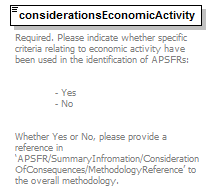 |
||||||||||||
| namespace | http://water.eionet.europa.eu/schemas/dir200760ec | ||||||||||||
| type | YesNoCode | ||||||||||||
| properties |
|
||||||||||||
| facets |
|
||||||||||||
| annotation |
|
||||||||||||
| source | <xs:element name="considerationsEconomicActivity" type="fd:YesNoCode"> <xs:annotation> <xs:documentation>Required. Please indicate whether specific criteria relating to economic activity have been used in the identification of APSFRs: - Yes - No Whether Yes or No, please provide a reference in ‘APSFR/SummaryInfromation/ConsiderationOfConsequences/MethodologyReference’ to the overall methodology.</xs:documentation> </xs:annotation> </xs:element> |
element ConsiderationsOfConsequences/methodologyReference
| diagram | 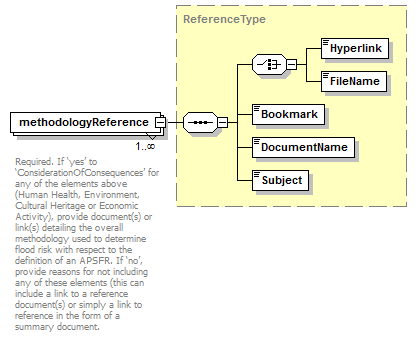 |
||||||||
| namespace | http://water.eionet.europa.eu/schemas/dir200760ec | ||||||||
| type | ReferenceType | ||||||||
| properties |
|
||||||||
| children | Hyperlink FileName Bookmark DocumentName Subject | ||||||||
| annotation |
|
||||||||
| source | <xs:element name="methodologyReference" type="fd:ReferenceType" maxOccurs="unbounded"> <xs:annotation> <xs:documentation>Required. If ‘yes’ to ‘ConsiderationOfConsequences’ for any of the elements above (Human Health, Environment, Cultural Heritage or Economic Activity), provide document(s) or link(s) detailing the overall methodology used to determine flood risk with respect to the definition of an APSFR. If ‘no’, provide reasons for not including any of these elements (this can include a link to a reference document(s) or simply a link to reference in the form of a summary document.</xs:documentation> </xs:annotation> </xs:element> |
complexType CriteriaForDeterminationSignificantFloodRisk
| diagram | 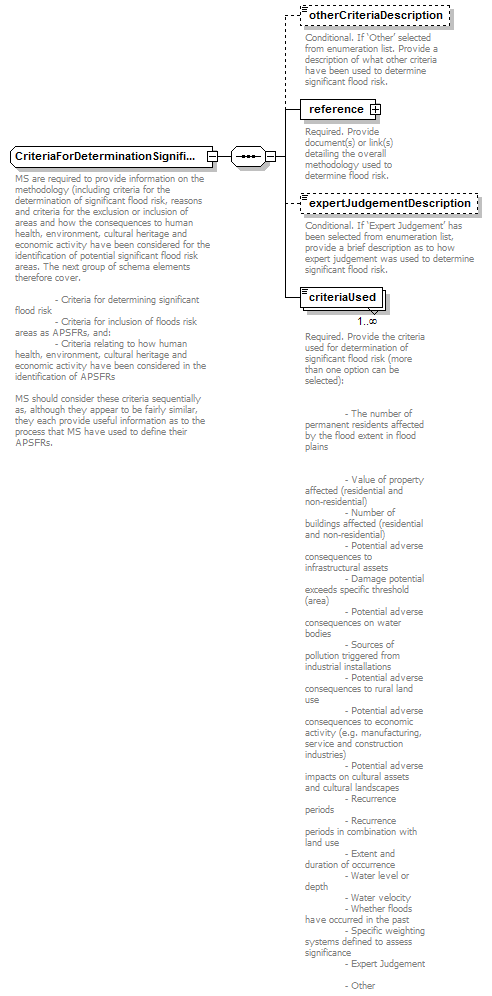 |
||
| namespace | http://water.eionet.europa.eu/schemas/dir200760ec | ||
| children | otherCriteriaDescription reference expertJudgementDescription criteriaUsed | ||
| used by |
|
||
| annotation |
|
||
| source | <xs:complexType name="CriteriaForDeterminationSignificantFloodRisk"> <xs:annotation> <xs:documentation>MS are required to provide information on the methodology (including criteria for the determination of significant flood risk, reasons and criteria for the exclusion or inclusion of areas and how the consequences to human health, environment, cultural heritage and economic activity have been considered for the identification of potential significant flood risk areas. The next group of schema elements therefore cover. - Criteria for determining significant flood risk - Criteria for inclusion of floods risk areas as APSFRs, and: - Criteria relating to how human health, environment, cultural heritage and economic activity have been considered in the identification of APSFRs MS should consider these criteria sequentially as, although they appear to be fairly similar, they each provide useful information as to the process that MS have used to define their APSFRs. </xs:documentation> </xs:annotation> <xs:sequence> <xs:element name="otherCriteriaDescription" type="fd:String1000Type" minOccurs="0"> <xs:annotation> <xs:documentation>Conditional. If ‘Other’ selected from enumeration list. Provide a description of what other criteria have been used to determine significant flood risk.</xs:documentation> </xs:annotation> </xs:element> <xs:element name="reference" type="fd:ReferenceType"> <xs:annotation> <xs:documentation>Required. Provide document(s) or link(s) detailing the overall methodology used to determine flood risk. </xs:documentation> </xs:annotation> </xs:element> <xs:element name="expertJudgementDescription" type="xs:string" minOccurs="0"> <xs:annotation> <xs:documentation>Conditional. If ‘Expert Judgement’ has been selected from enumeration list, provide a brief description as to how expert judgement was used to determine significant flood risk.</xs:documentation> </xs:annotation> </xs:element> <xs:element name="criteriaUsed" type="fd:CriteriaForDeterminationFloodRisk_Enum" maxOccurs="unbounded"> <xs:annotation> <xs:documentation>Required. Provide the criteria used for determination of significant flood risk (more than one option can be selected): - The number of permanent residents affected by the flood extent in flood plains - Value of property affected (residential and non-residential) - Number of buildings affected (residential and non-residential) - Potential adverse consequences to infrastructural assets - Damage potential exceeds specific threshold (area) - Potential adverse consequences on water bodies - Sources of pollution triggered from industrial installations - Potential adverse consequences to rural land use - Potential adverse consequences to economic activity (e.g. manufacturing, service and construction industries) - Potential adverse impacts on cultural assets and cultural landscapes - Recurrence periods - Recurrence periods in combination with land use - Extent and duration of occurrence - Water level or depth - Water velocity - Whether floods have occurred in the past - Specific weighting systems defined to assess significance - Expert Judgement - Other </xs:documentation> </xs:annotation> </xs:element> </xs:sequence> </xs:complexType> |
element CriteriaForDeterminationSignificantFloodRisk/otherCriteriaDescription
| diagram |  |
|||||||||
| namespace | http://water.eionet.europa.eu/schemas/dir200760ec | |||||||||
| type | String1000Type | |||||||||
| properties |
|
|||||||||
| facets |
|
|||||||||
| annotation |
|
|||||||||
| source | <xs:element name="otherCriteriaDescription" type="fd:String1000Type" minOccurs="0"> <xs:annotation> <xs:documentation>Conditional. If ‘Other’ selected from enumeration list. Provide a description of what other criteria have been used to determine significant flood risk.</xs:documentation> </xs:annotation> </xs:element> |
element CriteriaForDeterminationSignificantFloodRisk/reference
| diagram | 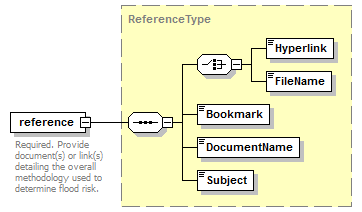 |
||||
| namespace | http://water.eionet.europa.eu/schemas/dir200760ec | ||||
| type | ReferenceType | ||||
| properties |
|
||||
| children | Hyperlink FileName Bookmark DocumentName Subject | ||||
| annotation |
|
||||
| source | <xs:element name="reference" type="fd:ReferenceType"> <xs:annotation> <xs:documentation>Required. Provide document(s) or link(s) detailing the overall methodology used to determine flood risk. </xs:documentation> </xs:annotation> </xs:element> |
element CriteriaForDeterminationSignificantFloodRisk/expertJudgementDescription
| diagram |  |
||||||||
| namespace | http://water.eionet.europa.eu/schemas/dir200760ec | ||||||||
| type | xs:string | ||||||||
| properties |
|
||||||||
| annotation |
|
||||||||
| source | <xs:element name="expertJudgementDescription" type="xs:string" minOccurs="0"> <xs:annotation> <xs:documentation>Conditional. If ‘Expert Judgement’ has been selected from enumeration list, provide a brief description as to how expert judgement was used to determine significant flood risk.</xs:documentation> </xs:annotation> </xs:element> |
element CriteriaForDeterminationSignificantFloodRisk/criteriaUsed
| diagram |  |
|||||||||||||||||||||||||||||||||||||||||||||||||||||||||||||||||||||
| namespace | http://water.eionet.europa.eu/schemas/dir200760ec | |||||||||||||||||||||||||||||||||||||||||||||||||||||||||||||||||||||
| type | CriteriaForDeterminationFloodRisk_Enum | |||||||||||||||||||||||||||||||||||||||||||||||||||||||||||||||||||||
| properties |
|
|||||||||||||||||||||||||||||||||||||||||||||||||||||||||||||||||||||
| facets |
|
|||||||||||||||||||||||||||||||||||||||||||||||||||||||||||||||||||||
| annotation |
|
|||||||||||||||||||||||||||||||||||||||||||||||||||||||||||||||||||||
| source | <xs:element name="criteriaUsed" type="fd:CriteriaForDeterminationFloodRisk_Enum" maxOccurs="unbounded"> <xs:annotation> <xs:documentation>Required. Provide the criteria used for determination of significant flood risk (more than one option can be selected): - The number of permanent residents affected by the flood extent in flood plains - Value of property affected (residential and non-residential) - Number of buildings affected (residential and non-residential) - Potential adverse consequences to infrastructural assets - Damage potential exceeds specific threshold (area) - Potential adverse consequences on water bodies - Sources of pollution triggered from industrial installations - Potential adverse consequences to rural land use - Potential adverse consequences to economic activity (e.g. manufacturing, service and construction industries) - Potential adverse impacts on cultural assets and cultural landscapes - Recurrence periods - Recurrence periods in combination with land use - Extent and duration of occurrence - Water level or depth - Water velocity - Whether floods have occurred in the past - Specific weighting systems defined to assess significance - Expert Judgement - Other </xs:documentation> </xs:annotation> </xs:element> |
complexType CriteriaForInclusion
| diagram | 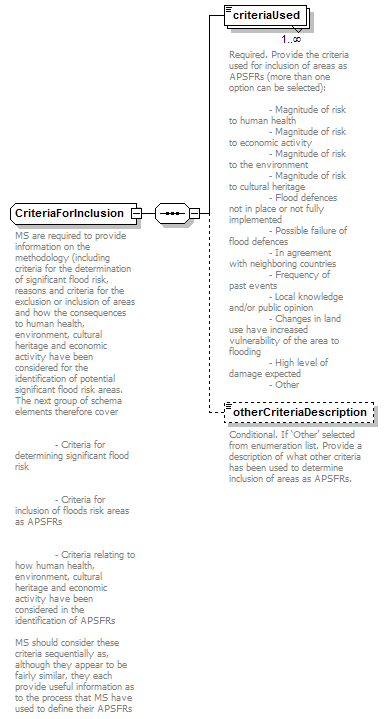 |
||
| namespace | http://water.eionet.europa.eu/schemas/dir200760ec | ||
| children | criteriaUsed otherCriteriaDescription | ||
| used by |
|
||
| annotation |
|
||
| source | <xs:complexType name="CriteriaForInclusion"> <xs:annotation> <xs:documentation>MS are required to provide information on the methodology (including criteria for the determination of significant flood risk, reasons and criteria for the exclusion or inclusion of areas and how the consequences to human health, environment, cultural heritage and economic activity have been considered for the identification of potential significant flood risk areas. The next group of schema elements therefore cover - Criteria for determining significant flood risk - Criteria for inclusion of floods risk areas as APSFRs - Criteria relating to how human health, environment, cultural heritage and economic activity have been considered in the identification of APSFRs MS should consider these criteria sequentially as, although they appear to be fairly similar, they each provide useful information as to the process that MS have used to define their APSFRs</xs:documentation> </xs:annotation> <xs:sequence> <xs:element name="criteriaUsed" type="fd:CriteriaForExclusionOrInclusion_Enum" maxOccurs="unbounded"> <xs:annotation> <xs:documentation>Required. Provide the criteria used for inclusion of areas as APSFRs (more than one option can be selected): - Magnitude of risk to human health - Magnitude of risk to economic activity - Magnitude of risk to the environment - Magnitude of risk to cultural heritage - Flood defences not in place or not fully implemented - Possible failure of flood defences - In agreement with neighboring countries - Frequency of past events - Local knowledge and/or public opinion - Changes in land use have increased vulnerability of the area to flooding - High level of damage expected - Other </xs:documentation> </xs:annotation> </xs:element> <xs:element name="otherCriteriaDescription" type="fd:String1000Type" minOccurs="0"> <xs:annotation> <xs:documentation>Conditional. If ‘Other’ selected from enumeration list. Provide a description of what other criteria has been used to determine inclusion of areas as APSFRs.</xs:documentation> </xs:annotation> </xs:element> </xs:sequence> </xs:complexType> |
element CriteriaForInclusion/criteriaUsed
| diagram | 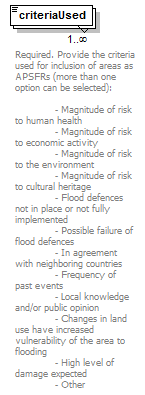 |
||||||||||||||||||||||||||||||||||||||||||||||||
| namespace | http://water.eionet.europa.eu/schemas/dir200760ec | ||||||||||||||||||||||||||||||||||||||||||||||||
| type | CriteriaForExclusionOrInclusion_Enum | ||||||||||||||||||||||||||||||||||||||||||||||||
| properties |
|
||||||||||||||||||||||||||||||||||||||||||||||||
| facets |
|
||||||||||||||||||||||||||||||||||||||||||||||||
| annotation |
|
||||||||||||||||||||||||||||||||||||||||||||||||
| source | <xs:element name="criteriaUsed" type="fd:CriteriaForExclusionOrInclusion_Enum" maxOccurs="unbounded"> <xs:annotation> <xs:documentation>Required. Provide the criteria used for inclusion of areas as APSFRs (more than one option can be selected): - Magnitude of risk to human health - Magnitude of risk to economic activity - Magnitude of risk to the environment - Magnitude of risk to cultural heritage - Flood defences not in place or not fully implemented - Possible failure of flood defences - In agreement with neighboring countries - Frequency of past events - Local knowledge and/or public opinion - Changes in land use have increased vulnerability of the area to flooding - High level of damage expected - Other </xs:documentation> </xs:annotation> </xs:element> |
element CriteriaForInclusion/otherCriteriaDescription
| diagram |  |
|||||||||
| namespace | http://water.eionet.europa.eu/schemas/dir200760ec | |||||||||
| type | String1000Type | |||||||||
| properties |
|
|||||||||
| facets |
|
|||||||||
| annotation |
|
|||||||||
| source | <xs:element name="otherCriteriaDescription" type="fd:String1000Type" minOccurs="0"> <xs:annotation> <xs:documentation>Conditional. If ‘Other’ selected from enumeration list. Provide a description of what other criteria has been used to determine inclusion of areas as APSFRs.</xs:documentation> </xs:annotation> </xs:element> |
complexType CulturalHeritage
| diagram | 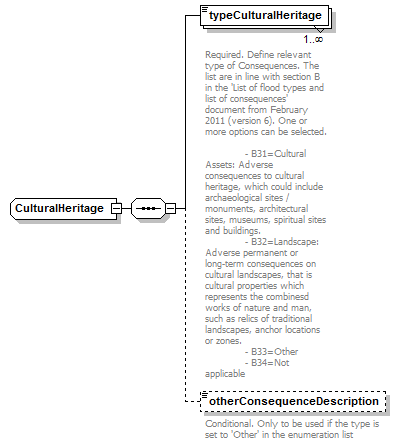 |
||
| namespace | http://water.eionet.europa.eu/schemas/dir200760ec | ||
| children | typeCulturalHeritage otherConsequenceDescription | ||
| used by |
|
||
| source | <xs:complexType name="CulturalHeritage"> <xs:sequence> <xs:element name="typeCulturalHeritage" type="fd:TypeCulturalHeritage_Enum" maxOccurs="unbounded"> <xs:annotation> <xs:documentation>Required. Define relevant type of Consequences. The list are in line with section B in the 'List of flood types and list of consequences' document from February 2011 (version 6). One or more options can be selected. - B31=Cultural Assets: Adverse consequences to cultural heritage, which could include archaeological sites / monuments, architectural sites, museums, spiritual sites and buildings. - B32=Landscape: Adverse permanent or long-term consequences on cultural landscapes, that is cultural properties which represents the combinesd works of nature and man, such as relics of traditional landscapes, anchor locations or zones. - B33=Other - B34=Not applicable </xs:documentation> </xs:annotation> </xs:element> <xs:element name="otherConsequenceDescription" type="fd:String250Type" minOccurs="0"> <xs:annotation> <xs:documentation>Conditional. Only to be used if the type is set to 'Other' in the enumeration list</xs:documentation> </xs:annotation> </xs:element> </xs:sequence> </xs:complexType> |
element CulturalHeritage/typeCulturalHeritage
| diagram | 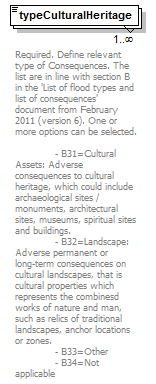 |
|||||||||||||||
| namespace | http://water.eionet.europa.eu/schemas/dir200760ec | |||||||||||||||
| type | TypeCulturalHeritage_Enum | |||||||||||||||
| properties |
|
|||||||||||||||
| facets |
|
|||||||||||||||
| annotation |
|
|||||||||||||||
| source | <xs:element name="typeCulturalHeritage" type="fd:TypeCulturalHeritage_Enum" maxOccurs="unbounded"> <xs:annotation> <xs:documentation>Required. Define relevant type of Consequences. The list are in line with section B in the 'List of flood types and list of consequences' document from February 2011 (version 6). One or more options can be selected. - B31=Cultural Assets: Adverse consequences to cultural heritage, which could include archaeological sites / monuments, architectural sites, museums, spiritual sites and buildings. - B32=Landscape: Adverse permanent or long-term consequences on cultural landscapes, that is cultural properties which represents the combinesd works of nature and man, such as relics of traditional landscapes, anchor locations or zones. - B33=Other - B34=Not applicable </xs:documentation> </xs:annotation> </xs:element> |
element CulturalHeritage/otherConsequenceDescription
| diagram |  |
|||||||||
| namespace | http://water.eionet.europa.eu/schemas/dir200760ec | |||||||||
| type | String250Type | |||||||||
| properties |
|
|||||||||
| facets |
|
|||||||||
| annotation |
|
|||||||||
| source | <xs:element name="otherConsequenceDescription" type="fd:String250Type" minOccurs="0"> <xs:annotation> <xs:documentation>Conditional. Only to be used if the type is set to 'Other' in the enumeration list</xs:documentation> </xs:annotation> </xs:element> |
complexType EconomicActivity
| diagram | 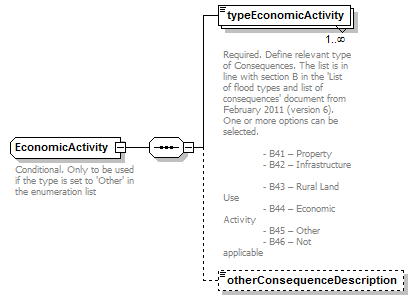 |
||
| namespace | http://water.eionet.europa.eu/schemas/dir200760ec | ||
| children | typeEconomicActivity otherConsequenceDescription | ||
| used by |
|
||
| annotation |
|
||
| source | <xs:complexType name="EconomicActivity"> <xs:annotation> <xs:documentation>Conditional. Only to be used if the type is set to 'Other' in the enumeration list</xs:documentation> </xs:annotation> <xs:sequence> <xs:element name="typeEconomicActivity" type="fd:TypeEconomicActivity_Enum" maxOccurs="unbounded"> <xs:annotation> <xs:documentation>Required. Define relevant type of Consequences. The list is in line with section B in the 'List of flood types and list of consequences' document from February 2011 (version 6). One or more options can be selected. - B41 – Property - B42 – Infrastructure - B43 – Rural Land Use - B44 – Economic Activity - B45 – Other - B46 – Not applicable </xs:documentation> </xs:annotation> </xs:element> <xs:element name="otherConsequenceDescription" type="fd:String250Type" minOccurs="0"/> </xs:sequence> </xs:complexType> |
element EconomicActivity/typeEconomicActivity
| diagram | 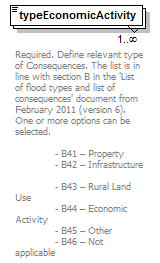 |
||||||||||||||||||||||||
| namespace | http://water.eionet.europa.eu/schemas/dir200760ec | ||||||||||||||||||||||||
| type | TypeEconomicActivity_Enum | ||||||||||||||||||||||||
| properties |
|
||||||||||||||||||||||||
| facets |
|
||||||||||||||||||||||||
| annotation |
|
||||||||||||||||||||||||
| source | <xs:element name="typeEconomicActivity" type="fd:TypeEconomicActivity_Enum" maxOccurs="unbounded"> <xs:annotation> <xs:documentation>Required. Define relevant type of Consequences. The list is in line with section B in the 'List of flood types and list of consequences' document from February 2011 (version 6). One or more options can be selected. - B41 – Property - B42 – Infrastructure - B43 – Rural Land Use - B44 – Economic Activity - B45 – Other - B46 – Not applicable </xs:documentation> </xs:annotation> </xs:element> |
element EconomicActivity/otherConsequenceDescription
| diagram | ||||||||||
| namespace | http://water.eionet.europa.eu/schemas/dir200760ec | |||||||||
| type | String250Type | |||||||||
| properties |
|
|||||||||
| facets |
|
|||||||||
| source | <xs:element name="otherConsequenceDescription" type="fd:String250Type" minOccurs="0"/> |
complexType Environment
| diagram | 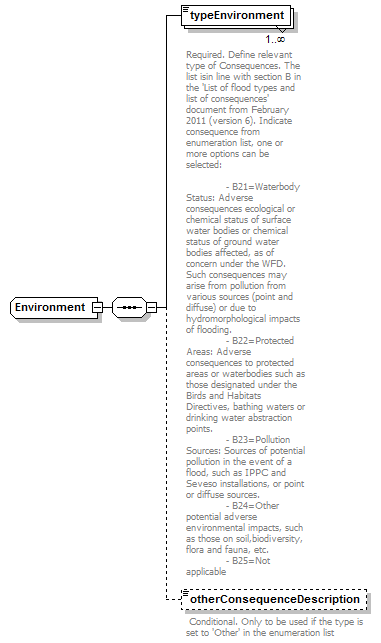 |
||
| namespace | http://water.eionet.europa.eu/schemas/dir200760ec | ||
| children | typeEnvironment otherConsequenceDescription | ||
| used by |
|
||
| source | <xs:complexType name="Environment"> <xs:sequence> <xs:element name="typeEnvironment" type="fd:TypeEnvironment_Enum" maxOccurs="unbounded"> <xs:annotation> <xs:documentation>Required. Define relevant type of Consequences. The list isin line with section B in the 'List of flood types and list of consequences' document from February 2011 (version 6). Indicate consequence from enumeration list, one or more options can be selected: - B21=Waterbody Status: Adverse consequences ecological or chemical status of surface water bodies or chemical status of ground water bodies affected, as of concern under the WFD. Such consequences may arise from pollution from various sources (point and diffuse) or due to hydromorphological impacts of flooding. - B22=Protected Areas: Adverse consequences to protected areas or waterbodies such as those designated under the Birds and Habitats Directives, bathing waters or drinking water abstraction points. - B23=Pollution Sources: Sources of potential pollution in the event of a flood, such as IPPC and Seveso installations, or point or diffuse sources. - B24=Other potential adverse environmental impacts, such as those on soil,biodiversity, flora and fauna, etc. - B25=Not applicable</xs:documentation> </xs:annotation> </xs:element> <xs:element name="otherConsequenceDescription" type="fd:String250Type" minOccurs="0"> <xs:annotation> <xs:documentation> Conditional. Only to be used if the type is set to 'Other' in the enumeration list</xs:documentation> </xs:annotation> </xs:element> </xs:sequence> </xs:complexType> |
element Environment/typeEnvironment
| diagram |  |
|||||||||||||||||||||
| namespace | http://water.eionet.europa.eu/schemas/dir200760ec | |||||||||||||||||||||
| type | TypeEnvironment_Enum | |||||||||||||||||||||
| properties |
|
|||||||||||||||||||||
| facets |
|
|||||||||||||||||||||
| annotation |
|
|||||||||||||||||||||
| source | <xs:element name="typeEnvironment" type="fd:TypeEnvironment_Enum" maxOccurs="unbounded"> <xs:annotation> <xs:documentation>Required. Define relevant type of Consequences. The list isin line with section B in the 'List of flood types and list of consequences' document from February 2011 (version 6). Indicate consequence from enumeration list, one or more options can be selected: - B21=Waterbody Status: Adverse consequences ecological or chemical status of surface water bodies or chemical status of ground water bodies affected, as of concern under the WFD. Such consequences may arise from pollution from various sources (point and diffuse) or due to hydromorphological impacts of flooding. - B22=Protected Areas: Adverse consequences to protected areas or waterbodies such as those designated under the Birds and Habitats Directives, bathing waters or drinking water abstraction points. - B23=Pollution Sources: Sources of potential pollution in the event of a flood, such as IPPC and Seveso installations, or point or diffuse sources. - B24=Other potential adverse environmental impacts, such as those on soil,biodiversity, flora and fauna, etc. - B25=Not applicable</xs:documentation> </xs:annotation> </xs:element> |
element Environment/otherConsequenceDescription
| diagram |  |
|||||||||
| namespace | http://water.eionet.europa.eu/schemas/dir200760ec | |||||||||
| type | String250Type | |||||||||
| properties |
|
|||||||||
| facets |
|
|||||||||
| annotation |
|
|||||||||
| source | <xs:element name="otherConsequenceDescription" type="fd:String250Type" minOccurs="0"> <xs:annotation> <xs:documentation> Conditional. Only to be used if the type is set to 'Other' in the enumeration list</xs:documentation> </xs:annotation> </xs:element> |
complexType HumanHealthSocial
| diagram | 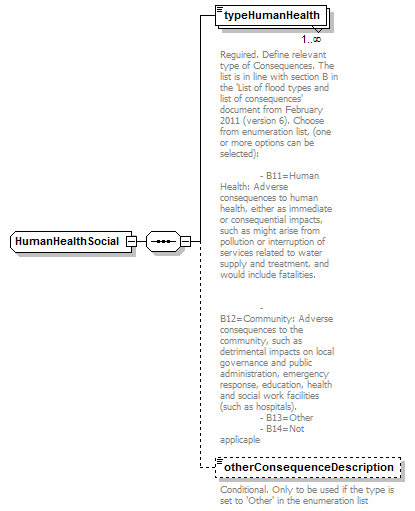 |
||
| namespace | http://water.eionet.europa.eu/schemas/dir200760ec | ||
| children | typeHumanHealth otherConsequenceDescription | ||
| used by |
|
||
| source | <xs:complexType name="HumanHealthSocial"> <xs:sequence> <xs:element name="typeHumanHealth" type="fd:TypeHumanHealth_Enum" maxOccurs="unbounded"> <xs:annotation> <xs:documentation>Reguired. Define relevant type of Consequences. The list is in line with section B in the 'List of flood types and list of consequences' document from February 2011 (version 6). Choose from enumeration list, (one or more options can be selected): - B11=Human Health: Adverse consequences to human health, either as immediate or consequential impacts, such as might arise from pollution or interruption of services related to water supply and treatment, and would include fatalities. - B12=Community: Adverse consequences to the community, such as detrimental impacts on local governance and public administration, emergency response, education, health and social work facilities (such as hospitals). - B13=Other - B14=Not applicaple</xs:documentation> </xs:annotation> </xs:element> <xs:element name="otherConsequenceDescription" type="fd:String250Type" minOccurs="0"> <xs:annotation> <xs:documentation>Conditional. Only to be used if the type is set to 'Other' in the enumeration list</xs:documentation> </xs:annotation> </xs:element> </xs:sequence> </xs:complexType> |
element HumanHealthSocial/typeHumanHealth
| diagram |  |
||||||||||||||||||
| namespace | http://water.eionet.europa.eu/schemas/dir200760ec | ||||||||||||||||||
| type | TypeHumanHealth_Enum | ||||||||||||||||||
| properties |
|
||||||||||||||||||
| facets |
|
||||||||||||||||||
| annotation |
|
||||||||||||||||||
| source | <xs:element name="typeHumanHealth" type="fd:TypeHumanHealth_Enum" maxOccurs="unbounded"> <xs:annotation> <xs:documentation>Reguired. Define relevant type of Consequences. The list is in line with section B in the 'List of flood types and list of consequences' document from February 2011 (version 6). Choose from enumeration list, (one or more options can be selected): - B11=Human Health: Adverse consequences to human health, either as immediate or consequential impacts, such as might arise from pollution or interruption of services related to water supply and treatment, and would include fatalities. - B12=Community: Adverse consequences to the community, such as detrimental impacts on local governance and public administration, emergency response, education, health and social work facilities (such as hospitals). - B13=Other - B14=Not applicaple</xs:documentation> </xs:annotation> </xs:element> |
element HumanHealthSocial/otherConsequenceDescription
| diagram |  |
|||||||||
| namespace | http://water.eionet.europa.eu/schemas/dir200760ec | |||||||||
| type | String250Type | |||||||||
| properties |
|
|||||||||
| facets |
|
|||||||||
| annotation |
|
|||||||||
| source | <xs:element name="otherConsequenceDescription" type="fd:String250Type" minOccurs="0"> <xs:annotation> <xs:documentation>Conditional. Only to be used if the type is set to 'Other' in the enumeration list</xs:documentation> </xs:annotation> </xs:element> |
complexType MechanismsOfInternationalCoordination
| diagram | 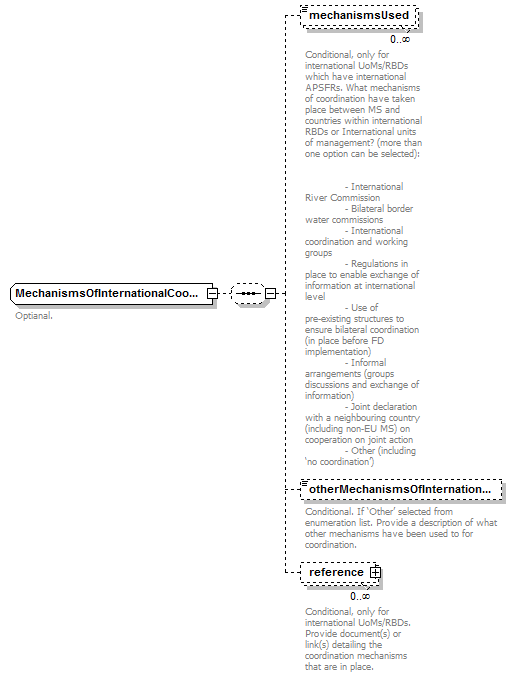 |
||
| namespace | http://water.eionet.europa.eu/schemas/dir200760ec | ||
| children | mechanismsUsed otherMechanismsOfInternationalCoordination reference | ||
| used by |
|
||
| annotation |
|
||
| source | <xs:complexType name="MechanismsOfInternationalCoordination"> <xs:annotation> <xs:documentation>Optianal.</xs:documentation> </xs:annotation> <xs:sequence minOccurs="0"> <xs:element name="mechanismsUsed" type="fd:MechanismsOfInternationalCoordination_Enum" minOccurs="0" maxOccurs="unbounded"> <xs:annotation> <xs:documentation>Conditional, only for international UoMs/RBDs which have international APSFRs. What mechanisms of coordination have taken place between MS and countries within international RBDs or International units of management? (more than one option can be selected): - International River Commission - Bilateral border water commissions - International coordination and working groups - Regulations in place to enable exchange of information at international level - Use of pre-existing structures to ensure bilateral coordination (in place before FD implementation) - Informal arrangements (groups discussions and exchange of information) - Joint declaration with a neighbouring country (including non-EU MS) on cooperation on joint action - Other (including ‘no coordination’) </xs:documentation> </xs:annotation> </xs:element> <xs:element name="otherMechanismsOfInternationalCoordination" type="fd:String1000Type" minOccurs="0"> <xs:annotation> <xs:documentation>Conditional. If ‘Other’ selected from enumeration list. Provide a description of what other mechanisms have been used to for coordination.</xs:documentation> </xs:annotation> </xs:element> <xs:element name="reference" type="fd:ReferenceType" minOccurs="0" maxOccurs="unbounded"> <xs:annotation> <xs:documentation>Conditional, only for international UoMs/RBDs. Provide document(s) or link(s) detailing the coordination mechanisms that are in place.</xs:documentation> </xs:annotation> </xs:element> </xs:sequence> </xs:complexType> |
element MechanismsOfInternationalCoordination/mechanismsUsed
| diagram |  |
|||||||||||||||||||||||||||
| namespace | http://water.eionet.europa.eu/schemas/dir200760ec | |||||||||||||||||||||||||||
| type | MechanismsOfInternationalCoordination_Enum | |||||||||||||||||||||||||||
| properties |
|
|||||||||||||||||||||||||||
| facets |
|
|||||||||||||||||||||||||||
| annotation |
|
|||||||||||||||||||||||||||
| source | <xs:element name="mechanismsUsed" type="fd:MechanismsOfInternationalCoordination_Enum" minOccurs="0" maxOccurs="unbounded"> <xs:annotation> <xs:documentation>Conditional, only for international UoMs/RBDs which have international APSFRs. What mechanisms of coordination have taken place between MS and countries within international RBDs or International units of management? (more than one option can be selected): - International River Commission - Bilateral border water commissions - International coordination and working groups - Regulations in place to enable exchange of information at international level - Use of pre-existing structures to ensure bilateral coordination (in place before FD implementation) - Informal arrangements (groups discussions and exchange of information) - Joint declaration with a neighbouring country (including non-EU MS) on cooperation on joint action - Other (including ‘no coordination’) </xs:documentation> </xs:annotation> </xs:element> |
element MechanismsOfInternationalCoordination/otherMechanismsOfInternationalCoordination
| diagram |  |
|||||||||
| namespace | http://water.eionet.europa.eu/schemas/dir200760ec | |||||||||
| type | String1000Type | |||||||||
| properties |
|
|||||||||
| facets |
|
|||||||||
| annotation |
|
|||||||||
| source | <xs:element name="otherMechanismsOfInternationalCoordination" type="fd:String1000Type" minOccurs="0"> <xs:annotation> <xs:documentation>Conditional. If ‘Other’ selected from enumeration list. Provide a description of what other mechanisms have been used to for coordination.</xs:documentation> </xs:annotation> </xs:element> |
element MechanismsOfInternationalCoordination/reference
| diagram | 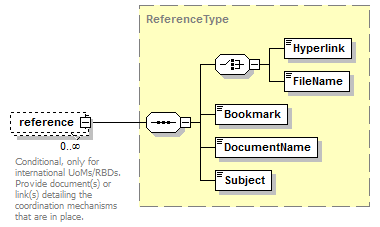 |
||||||||
| namespace | http://water.eionet.europa.eu/schemas/dir200760ec | ||||||||
| type | ReferenceType | ||||||||
| properties |
|
||||||||
| children | Hyperlink FileName Bookmark DocumentName Subject | ||||||||
| annotation |
|
||||||||
| source | <xs:element name="reference" type="fd:ReferenceType" minOccurs="0" maxOccurs="unbounded"> <xs:annotation> <xs:documentation>Conditional, only for international UoMs/RBDs. Provide document(s) or link(s) detailing the coordination mechanisms that are in place.</xs:documentation> </xs:annotation> </xs:element> |
complexType SummaryInformation
| diagram | 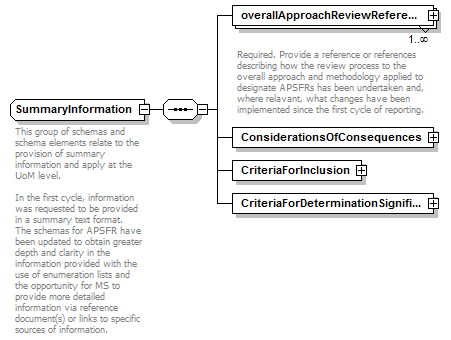 |
||
| namespace | http://water.eionet.europa.eu/schemas/dir200760ec | ||
| children | overallApproachReviewReference ConsiderationsOfConsequences CriteriaForInclusion CriteriaForDeterminationSignificantFloodRisk | ||
| used by |
|
||
| annotation |
|
||
| source | <xs:complexType name="SummaryInformation"> <xs:annotation> <xs:documentation>This group of schemas and schema elements relate to the provision of summary information and apply at the UoM level. In the first cycle, information was requested to be provided in a summary text format. The schemas for APSFR have been updated to obtain greater depth and clarity in the information provided with the use of enumeration lists and the opportunity for MS to provide more detailed information via reference document(s) or links to specific sources of information.</xs:documentation> </xs:annotation> <xs:sequence> <xs:element name="overallApproachReviewReference" type="fd:ReferenceType" maxOccurs="unbounded"> <xs:annotation> <xs:documentation>Required. Provide a reference or references describing how the review process to the overall approach and methodology applied to designate APSFRs has been undertaken and, where relavant, what changes have been implemented since the first cycle of reporting.</xs:documentation> </xs:annotation> </xs:element> <xs:element name="ConsiderationsOfConsequences" type="ConsiderationsOfConsequences"/> <xs:element name="CriteriaForInclusion" type="CriteriaForInclusion"/> <xs:element name="CriteriaForDeterminationSignificantFloodRisk" type="CriteriaForDeterminationSignificantFloodRisk"/> </xs:sequence> </xs:complexType> |
element SummaryInformation/overallApproachReviewReference
| diagram | 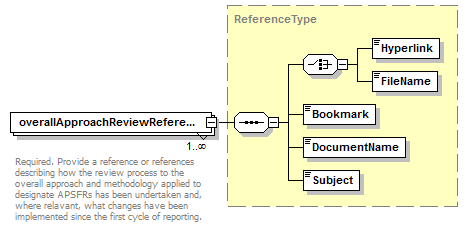 |
||||||||
| namespace | http://water.eionet.europa.eu/schemas/dir200760ec | ||||||||
| type | ReferenceType | ||||||||
| properties |
|
||||||||
| children | Hyperlink FileName Bookmark DocumentName Subject | ||||||||
| annotation |
|
||||||||
| source | <xs:element name="overallApproachReviewReference" type="fd:ReferenceType" maxOccurs="unbounded"> <xs:annotation> <xs:documentation>Required. Provide a reference or references describing how the review process to the overall approach and methodology applied to designate APSFRs has been undertaken and, where relavant, what changes have been implemented since the first cycle of reporting.</xs:documentation> </xs:annotation> </xs:element> |
element SummaryInformation/ConsiderationsOfConsequences
| diagram | 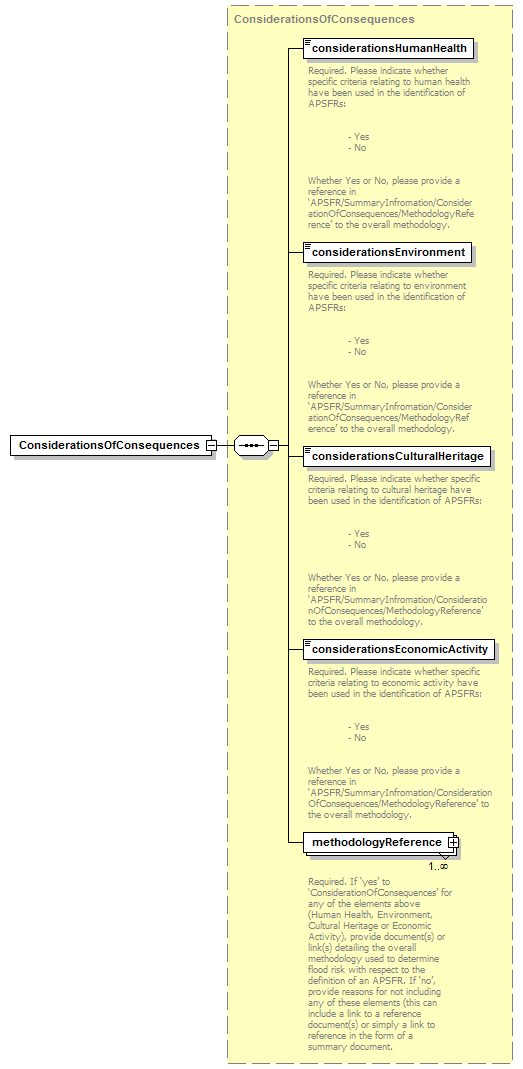 |
||||
| namespace | http://water.eionet.europa.eu/schemas/dir200760ec | ||||
| type | ConsiderationsOfConsequences | ||||
| properties |
|
||||
| children | considerationsHumanHealth considerationsEnvironment considerationsCulturalHeritage considerationsEconomicActivity methodologyReference | ||||
| source | <xs:element name="ConsiderationsOfConsequences" type="ConsiderationsOfConsequences"/> |
element SummaryInformation/CriteriaForInclusion
| diagram | 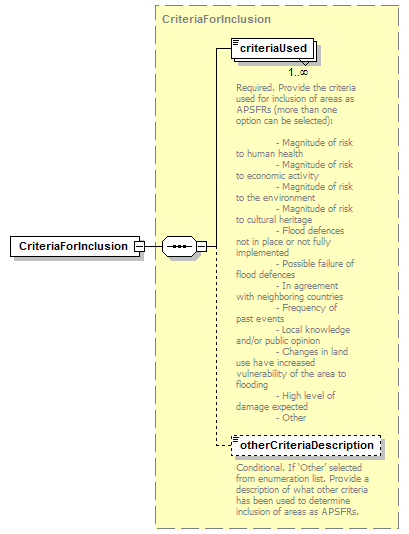 |
||||
| namespace | http://water.eionet.europa.eu/schemas/dir200760ec | ||||
| type | CriteriaForInclusion | ||||
| properties |
|
||||
| children | criteriaUsed otherCriteriaDescription | ||||
| source | <xs:element name="CriteriaForInclusion" type="CriteriaForInclusion"/> |
element SummaryInformation/CriteriaForDeterminationSignificantFloodRisk
| diagram | 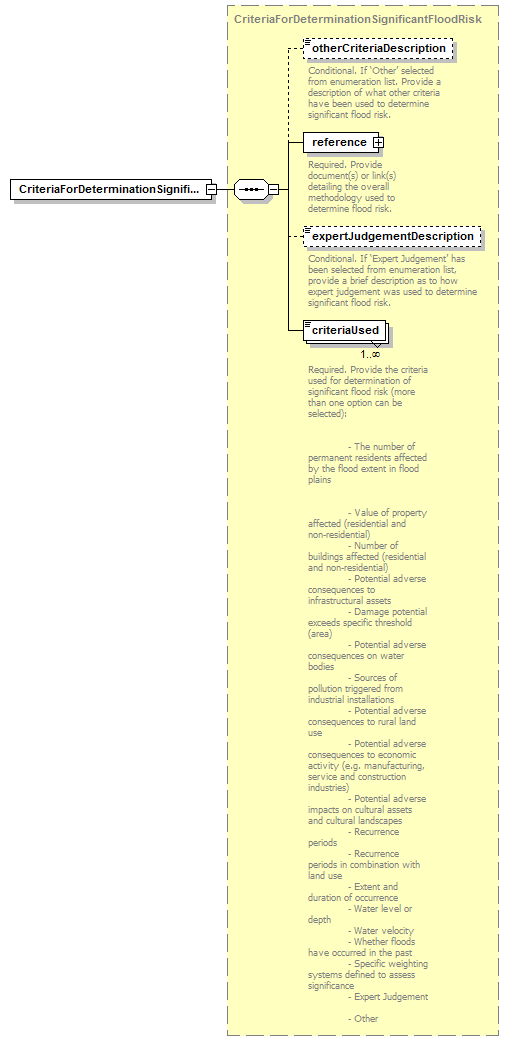 |
||||
| namespace | http://water.eionet.europa.eu/schemas/dir200760ec | ||||
| type | CriteriaForDeterminationSignificantFloodRisk | ||||
| properties |
|
||||
| children | otherCriteriaDescription reference expertJudgementDescription criteriaUsed | ||||
| source | <xs:element name="CriteriaForDeterminationSignificantFloodRisk" type="CriteriaForDeterminationSignificantFloodRisk"/> |
complexType TypeOfFloods
| diagram |  |
||
| namespace | http://water.eionet.europa.eu/schemas/dir200760ec | ||
| children | sourceOfFlooding otherSource sourceUncertainDescription mechanismOfFlooding otherMechanismDescription mechanismUncertain characteristicsOfFlooding otherCharacteristicsDecsription characteristicsUncertain | ||
| used by |
|
||
| source | <xs:complexType name="TypeOfFloods"> <xs:sequence> <xs:element name="sourceOfFlooding" type="fd:SourceofFlooding_Enum" maxOccurs="unbounded"> <xs:annotation> <xs:documentation>Required. Indicate the source of floods from the enumeration list (one or more options can be selected). - A11=Fluvial: Flooding of land by waters originating from part of a natural drainage system, including natural or modified drainage channels. This source could include flooding from rivers, streams, drainage channels, mountain torrents and ephemeral watercourses, lakes and floods arising from snow melt. - A12=Pluvial: Flooding of land directly from rainfall water falling on, or flowing over, the land. This source could include urban storm water, rural overland flow or excess water, or overland floods arising from snowmelt. - A13=Groundwater: Flooding of land by waters from underground rising to above the land surface. This source could include rising groundwater and underground flow from elevated surface waters. - A14=Sea Water: Flooding of land by water from the sea, estuaries or coastal lakes. This source could include flooding from the sea (e.g., extreme tidal level and / or storm surges) or arising from wave action or coastal tsunamis. - A15=Artificial Water-Bearing Infrastructure: Flooding of land by water arising from artificial, water-bearing infrastructure or failure of such infrastructure. This source could include flooding arising from sewerage systems (including storm water, combined and foul sewers), water supply and wastewater treatment systems, artificial navigation canals and impoundments (e.g., dams and reservoirs). - A16=Other: Flooding of land by water due to other sources, can include other tsunamis. - A17=No data available on the source of flooding - A18=Source of flooding uncertain </xs:documentation> </xs:annotation> </xs:element> <xs:element name="otherSource" type="fd:String1000Type" minOccurs="0"> <xs:annotation> <xs:documentation>Conditional. If ‘A16=Other’ selected from enumeration list provide a description of the other source(s)</xs:documentation> </xs:annotation> </xs:element> <xs:element name="sourceUncertainDescription" type="fd:String1000Type" minOccurs="0"> <xs:annotation> <xs:documentation>Conditional. If ‘A18=Source of flooding uncertain’ selected from enumeration list provide a reason for the uncertainty</xs:documentation> </xs:annotation> </xs:element> <xs:element name="mechanismOfFlooding" type="fd:MechanismofFlooding_Enum" minOccurs="0" maxOccurs="unbounded"> <xs:annotation> <xs:documentation>Required. Indicate the mechanism of flooding from the enumeration list (one or more options can be selected). - A21=Natural Exceedance: Flooding of land by waters exceeding the capacity of their carrying channel or the level of adjacent lands. - A22=Defence Exceedance: Flooding of land due to floodwaters overtopping flood defences. - A23=Defence or Infrastructural Failure:Flooding of land due to the failure of natural or artificial defences or infrastructure. This mechanism of flooding could include the breaching or collapse of a flood defence or retention structure, or the failure in operation of pumping equipment or gates. - A24=Blockage / Restriction: Flooding of land due to a natural or artificial blockage or restriction of a conveyance channel or system. This mechanism of flooding could include the blockage of sewerage systems or due to restrictive channel structures such as bridges or culverts or arising from ice jams or land slides. - A25=Other: Flooding of land by water due to other mechanisms, for instance windsetup floods. - A26= No data available on the mechanism of flooding - A27=Mechanism of flooding uncertain </xs:documentation> </xs:annotation> </xs:element> <xs:element name="otherMechanismDescription" type="fd:String1000Type" minOccurs="0"> <xs:annotation> <xs:documentation>Conditional. If ‘A25=Other’ selected from enumeration list provide a description of the other mechanism(s)</xs:documentation> </xs:annotation> </xs:element> <xs:element name="mechanismUncertain" type="fd:String1000Type" minOccurs="0"/> <xs:element name="characteristicsOfFlooding" type="fd:CharacteristicsofFlooding_Enum" minOccurs="0" maxOccurs="unbounded"> <xs:annotation> <xs:documentation>Required. Define the relevant characteristics of flooding (one or more options can be selected). - A31=Flash Flood: A flood that rises and falls quite rapidly with little or no advance warning, usually the result of intense rainfall over a relatively small area. - A32=Snow Melt Flood: Flooding due to rapid snow melt, possibly in combination with rainfall or blockage due to ice jams. - A33=Other rapid onset: A flood which develops quickly, other than a flash flood . - A34=Medium onset flood: An onset of flooding, that occurs at a slower rate than a flash flood. - A35=Slow onset flood: A flood which takes a longer time to develop. - A36=Debris Flow: A flood conveying a high degree of debris. - A37=High Velocity Flow: A flood where the floodwaters are flowing at a high velocity. - A38=Deep Flood: A flood where the floodwaters are of significant depth. - A39=Other characteristics, or no special characteristics. - A40=No data available on characteristics of flooding - A41=Characteristics of flooding uncertain. </xs:documentation> </xs:annotation> </xs:element> <xs:element name="otherCharacteristicsDecsription" type="fd:String1000Type" minOccurs="0"> <xs:annotation> <xs:documentation>Conditional. If ‘A39=Other’ selected from enumeration list provide a description of the other characteristics or state whether there are no special characteristics</xs:documentation> </xs:annotation> </xs:element> <xs:element name="characteristicsUncertain" type="fd:String1000Type" minOccurs="0"> <xs:annotation> <xs:documentation>Conditional. If ‘A41=Characteristics of flooding uncertain’ selected from enumeration list provide a reason for the uncertainty</xs:documentation> </xs:annotation> </xs:element> </xs:sequence> </xs:complexType> |
element TypeOfFloods/sourceOfFlooding
| diagram |  |
|||||||||||||||||||||||||||
| namespace | http://water.eionet.europa.eu/schemas/dir200760ec | |||||||||||||||||||||||||||
| type | SourceofFlooding_Enum | |||||||||||||||||||||||||||
| properties |
|
|||||||||||||||||||||||||||
| facets |
|
|||||||||||||||||||||||||||
| annotation |
|
|||||||||||||||||||||||||||
| source | <xs:element name="sourceOfFlooding" type="fd:SourceofFlooding_Enum" maxOccurs="unbounded"> <xs:annotation> <xs:documentation>Required. Indicate the source of floods from the enumeration list (one or more options can be selected). - A11=Fluvial: Flooding of land by waters originating from part of a natural drainage system, including natural or modified drainage channels. This source could include flooding from rivers, streams, drainage channels, mountain torrents and ephemeral watercourses, lakes and floods arising from snow melt. - A12=Pluvial: Flooding of land directly from rainfall water falling on, or flowing over, the land. This source could include urban storm water, rural overland flow or excess water, or overland floods arising from snowmelt. - A13=Groundwater: Flooding of land by waters from underground rising to above the land surface. This source could include rising groundwater and underground flow from elevated surface waters. - A14=Sea Water: Flooding of land by water from the sea, estuaries or coastal lakes. This source could include flooding from the sea (e.g., extreme tidal level and / or storm surges) or arising from wave action or coastal tsunamis. - A15=Artificial Water-Bearing Infrastructure: Flooding of land by water arising from artificial, water-bearing infrastructure or failure of such infrastructure. This source could include flooding arising from sewerage systems (including storm water, combined and foul sewers), water supply and wastewater treatment systems, artificial navigation canals and impoundments (e.g., dams and reservoirs). - A16=Other: Flooding of land by water due to other sources, can include other tsunamis. - A17=No data available on the source of flooding - A18=Source of flooding uncertain </xs:documentation> </xs:annotation> </xs:element> |
element TypeOfFloods/otherSource
| diagram |  |
|||||||||
| namespace | http://water.eionet.europa.eu/schemas/dir200760ec | |||||||||
| type | String1000Type | |||||||||
| properties |
|
|||||||||
| facets |
|
|||||||||
| annotation |
|
|||||||||
| source | <xs:element name="otherSource" type="fd:String1000Type" minOccurs="0"> <xs:annotation> <xs:documentation>Conditional. If ‘A16=Other’ selected from enumeration list provide a description of the other source(s)</xs:documentation> </xs:annotation> </xs:element> |
element TypeOfFloods/sourceUncertainDescription
| diagram |  |
|||||||||
| namespace | http://water.eionet.europa.eu/schemas/dir200760ec | |||||||||
| type | String1000Type | |||||||||
| properties |
|
|||||||||
| facets |
|
|||||||||
| annotation |
|
|||||||||
| source | <xs:element name="sourceUncertainDescription" type="fd:String1000Type" minOccurs="0"> <xs:annotation> <xs:documentation>Conditional. If ‘A18=Source of flooding uncertain’ selected from enumeration list provide a reason for the uncertainty</xs:documentation> </xs:annotation> </xs:element> |
element TypeOfFloods/mechanismOfFlooding
| diagram |  |
||||||||||||||||||||||||
| namespace | http://water.eionet.europa.eu/schemas/dir200760ec | ||||||||||||||||||||||||
| type | MechanismofFlooding_Enum | ||||||||||||||||||||||||
| properties |
|
||||||||||||||||||||||||
| facets |
|
||||||||||||||||||||||||
| annotation |
|
||||||||||||||||||||||||
| source | <xs:element name="mechanismOfFlooding" type="fd:MechanismofFlooding_Enum" minOccurs="0" maxOccurs="unbounded"> <xs:annotation> <xs:documentation>Required. Indicate the mechanism of flooding from the enumeration list (one or more options can be selected). - A21=Natural Exceedance: Flooding of land by waters exceeding the capacity of their carrying channel or the level of adjacent lands. - A22=Defence Exceedance: Flooding of land due to floodwaters overtopping flood defences. - A23=Defence or Infrastructural Failure:Flooding of land due to the failure of natural or artificial defences or infrastructure. This mechanism of flooding could include the breaching or collapse of a flood defence or retention structure, or the failure in operation of pumping equipment or gates. - A24=Blockage / Restriction: Flooding of land due to a natural or artificial blockage or restriction of a conveyance channel or system. This mechanism of flooding could include the blockage of sewerage systems or due to restrictive channel structures such as bridges or culverts or arising from ice jams or land slides. - A25=Other: Flooding of land by water due to other mechanisms, for instance windsetup floods. - A26= No data available on the mechanism of flooding - A27=Mechanism of flooding uncertain </xs:documentation> </xs:annotation> </xs:element> |
element TypeOfFloods/otherMechanismDescription
| diagram |  |
|||||||||
| namespace | http://water.eionet.europa.eu/schemas/dir200760ec | |||||||||
| type | String1000Type | |||||||||
| properties |
|
|||||||||
| facets |
|
|||||||||
| annotation |
|
|||||||||
| source | <xs:element name="otherMechanismDescription" type="fd:String1000Type" minOccurs="0"> <xs:annotation> <xs:documentation>Conditional. If ‘A25=Other’ selected from enumeration list provide a description of the other mechanism(s)</xs:documentation> </xs:annotation> </xs:element> |
element TypeOfFloods/mechanismUncertain
| diagram | ||||||||||
| namespace | http://water.eionet.europa.eu/schemas/dir200760ec | |||||||||
| type | String1000Type | |||||||||
| properties |
|
|||||||||
| facets |
|
|||||||||
| source | <xs:element name="mechanismUncertain" type="fd:String1000Type" minOccurs="0"/> |
element TypeOfFloods/characteristicsOfFlooding
| diagram | 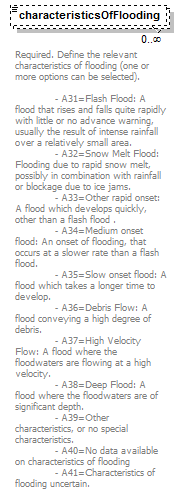 |
||||||||||||||||||||||||||||||||||||
| namespace | http://water.eionet.europa.eu/schemas/dir200760ec | ||||||||||||||||||||||||||||||||||||
| type | CharacteristicsofFlooding_Enum | ||||||||||||||||||||||||||||||||||||
| properties |
|
||||||||||||||||||||||||||||||||||||
| facets |
|
||||||||||||||||||||||||||||||||||||
| annotation |
|
||||||||||||||||||||||||||||||||||||
| source | <xs:element name="characteristicsOfFlooding" type="fd:CharacteristicsofFlooding_Enum" minOccurs="0" maxOccurs="unbounded"> <xs:annotation> <xs:documentation>Required. Define the relevant characteristics of flooding (one or more options can be selected). - A31=Flash Flood: A flood that rises and falls quite rapidly with little or no advance warning, usually the result of intense rainfall over a relatively small area. - A32=Snow Melt Flood: Flooding due to rapid snow melt, possibly in combination with rainfall or blockage due to ice jams. - A33=Other rapid onset: A flood which develops quickly, other than a flash flood . - A34=Medium onset flood: An onset of flooding, that occurs at a slower rate than a flash flood. - A35=Slow onset flood: A flood which takes a longer time to develop. - A36=Debris Flow: A flood conveying a high degree of debris. - A37=High Velocity Flow: A flood where the floodwaters are flowing at a high velocity. - A38=Deep Flood: A flood where the floodwaters are of significant depth. - A39=Other characteristics, or no special characteristics. - A40=No data available on characteristics of flooding - A41=Characteristics of flooding uncertain. </xs:documentation> </xs:annotation> </xs:element> |
element TypeOfFloods/otherCharacteristicsDecsription
| diagram |  |
|||||||||
| namespace | http://water.eionet.europa.eu/schemas/dir200760ec | |||||||||
| type | String1000Type | |||||||||
| properties |
|
|||||||||
| facets |
|
|||||||||
| annotation |
|
|||||||||
| source | <xs:element name="otherCharacteristicsDecsription" type="fd:String1000Type" minOccurs="0"> <xs:annotation> <xs:documentation>Conditional. If ‘A39=Other’ selected from enumeration list provide a description of the other characteristics or state whether there are no special characteristics</xs:documentation> </xs:annotation> </xs:element> |
element TypeOfFloods/characteristicsUncertain
| diagram |  |
|||||||||
| namespace | http://water.eionet.europa.eu/schemas/dir200760ec | |||||||||
| type | String1000Type | |||||||||
| properties |
|
|||||||||
| facets |
|
|||||||||
| annotation |
|
|||||||||
| source | <xs:element name="characteristicsUncertain" type="fd:String1000Type" minOccurs="0"> <xs:annotation> <xs:documentation>Conditional. If ‘A41=Characteristics of flooding uncertain’ selected from enumeration list provide a reason for the uncertainty</xs:documentation> </xs:annotation> </xs:element> |
complexType TypeofPotentialConsequences
| diagram | 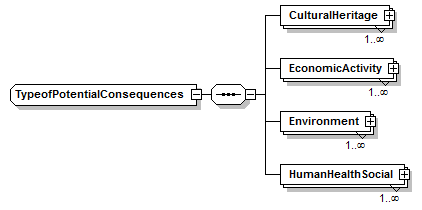 |
||
| namespace | http://water.eionet.europa.eu/schemas/dir200760ec | ||
| children | CulturalHeritage EconomicActivity Environment HumanHealthSocial | ||
| used by |
|
||
| source | <xs:complexType name="TypeofPotentialConsequences"> <xs:sequence> <xs:element name="CulturalHeritage" type="CulturalHeritage" maxOccurs="unbounded"/> <xs:element name="EconomicActivity" type="EconomicActivity" maxOccurs="unbounded"/> <xs:element name="Environment" type="Environment" maxOccurs="unbounded"/> <xs:element name="HumanHealthSocial" type="HumanHealthSocial" maxOccurs="unbounded"/> </xs:sequence> </xs:complexType> |
element TypeofPotentialConsequences/CulturalHeritage
| diagram | 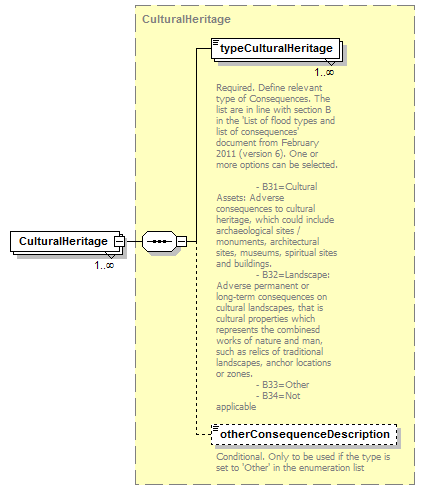 |
||||||||
| namespace | http://water.eionet.europa.eu/schemas/dir200760ec | ||||||||
| type | CulturalHeritage | ||||||||
| properties |
|
||||||||
| children | typeCulturalHeritage otherConsequenceDescription | ||||||||
| source | <xs:element name="CulturalHeritage" type="CulturalHeritage" maxOccurs="unbounded"/> |
element TypeofPotentialConsequences/EconomicActivity
| diagram | 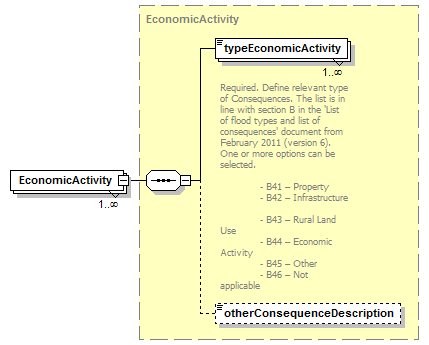 |
||||||||
| namespace | http://water.eionet.europa.eu/schemas/dir200760ec | ||||||||
| type | EconomicActivity | ||||||||
| properties |
|
||||||||
| children | typeEconomicActivity otherConsequenceDescription | ||||||||
| source | <xs:element name="EconomicActivity" type="EconomicActivity" maxOccurs="unbounded"/> |
element TypeofPotentialConsequences/Environment
| diagram | 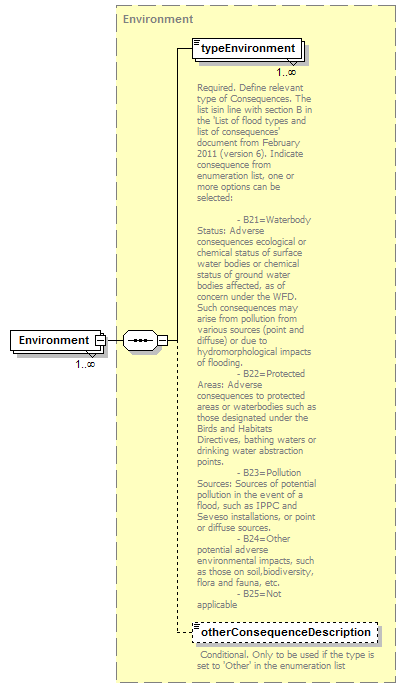 |
||||||||
| namespace | http://water.eionet.europa.eu/schemas/dir200760ec | ||||||||
| type | Environment | ||||||||
| properties |
|
||||||||
| children | typeEnvironment otherConsequenceDescription | ||||||||
| source | <xs:element name="Environment" type="Environment" maxOccurs="unbounded"/> |
element TypeofPotentialConsequences/HumanHealthSocial
| diagram | 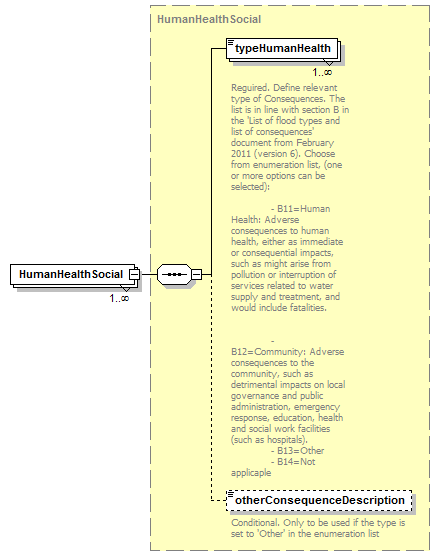 |
||||||||
| namespace | http://water.eionet.europa.eu/schemas/dir200760ec | ||||||||
| type | HumanHealthSocial | ||||||||
| properties |
|
||||||||
| children | typeHumanHealth otherConsequenceDescription | ||||||||
| source | <xs:element name="HumanHealthSocial" type="HumanHealthSocial" maxOccurs="unbounded"/> |
complexType ReferenceType
| diagram | 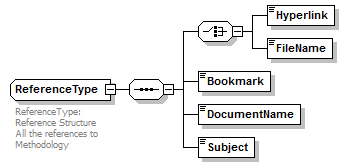 |
||
| namespace | http://water.eionet.europa.eu/schemas/dir200760ec/fdcommon | ||
| children | Hyperlink FileName Bookmark DocumentName Subject | ||
| used by | |||
| annotation |
|
||
| source | <xs:complexType name="ReferenceType"> <xs:annotation> <xs:documentation>ReferenceType: Reference Structure All the references to Methodology</xs:documentation> </xs:annotation> <xs:sequence> <xs:choice> <xs:element name="Hyperlink" type="URLType"/> <xs:element name="FileName" type="String50Type"/> </xs:choice> <xs:element name="Bookmark" type="String50Type"/> <xs:element name="DocumentName" type="String250Type"/> <xs:element name="Subject" type="String250Type"/> </xs:sequence> </xs:complexType> |
element ReferenceType/Hyperlink
| diagram | |||||||||||||
| namespace | http://water.eionet.europa.eu/schemas/dir200760ec/fdcommon | ||||||||||||
| type | URLType | ||||||||||||
| properties |
|
||||||||||||
| facets |
|
||||||||||||
| source | <xs:element name="Hyperlink" type="URLType"/> |
element ReferenceType/FileName
| diagram | ||||||||||
| namespace | http://water.eionet.europa.eu/schemas/dir200760ec/fdcommon | |||||||||
| type | String50Type | |||||||||
| properties |
|
|||||||||
| facets |
|
|||||||||
| source | <xs:element name="FileName" type="String50Type"/> |
element ReferenceType/Bookmark
| diagram | ||||||||||
| namespace | http://water.eionet.europa.eu/schemas/dir200760ec/fdcommon | |||||||||
| type | String50Type | |||||||||
| properties |
|
|||||||||
| facets |
|
|||||||||
| source | <xs:element name="Bookmark" type="String50Type"/> |
element ReferenceType/DocumentName
| diagram | ||||||||||
| namespace | http://water.eionet.europa.eu/schemas/dir200760ec/fdcommon | |||||||||
| type | String250Type | |||||||||
| properties |
|
|||||||||
| facets |
|
|||||||||
| source | <xs:element name="DocumentName" type="String250Type"/> |
element ReferenceType/Subject
| diagram | ||||||||||
| namespace | http://water.eionet.europa.eu/schemas/dir200760ec/fdcommon | |||||||||
| type | String250Type | |||||||||
| properties |
|
|||||||||
| facets |
|
|||||||||
| source | <xs:element name="Subject" type="String250Type"/> |
simpleType Article_6.6_Justification_Enum
| namespace | http://water.eionet.europa.eu/schemas/dir200760ec/fdcommon | |||||||||||||||
| type | restriction of xs:string | |||||||||||||||
| facets |
|
|||||||||||||||
| source | <xs:simpleType name="Article_6.6_Justification_Enum"> <xs:restriction base="xs:string"> <xs:enumeration value="Other justification (please specify)"/> <xs:enumeration value="Prevention of damage and damge potential through legal regulations for use (e.g. for the embankment foreland)"/> <xs:enumeration value="Risk of failure of existing defences assessed"/> <xs:enumeration value="Risk of overtopping of existing flood defences assessed"/> </xs:restriction> </xs:simpleType> |
simpleType Article_6.7_Justification_Enum
| namespace | http://water.eionet.europa.eu/schemas/dir200760ec/fdcommon | ||||||||||||||||||
| type | restriction of xs:string | ||||||||||||||||||
| facets |
|
||||||||||||||||||
| source | <xs:simpleType name="Article_6.7_Justification_Enum"> <xs:restriction base="xs:string"> <xs:enumeration value="Groundwater is considered as a contributing source rather than a main source of flooding"/> <xs:enumeration value="It is difficult to distinguish the impact of groundwater flooding from other sources of flooding"/> <xs:enumeration value="Only low probability groundwater flooding is assessed to be a hazardous risk"/> <xs:enumeration value="Other justification"/> <xs:enumeration value="There is limited information or historical records on groundwater flooding"/> </xs:restriction> </xs:simpleType> |
simpleType CategoryFloods_Enum
| namespace | http://water.eionet.europa.eu/schemas/dir200760ec/fdcommon | |||||||||
| type | restriction of xs:string | |||||||||
| facets |
|
|||||||||
| annotation |
|
|||||||||
| source | <xs:simpleType name="CategoryFloods_Enum"> <xs:annotation> <xs:documentation>Can be past flood (past) or potential future flood (future)</xs:documentation> </xs:annotation> <xs:restriction base="xs:string"> <xs:enumeration value="Past flood"/> <xs:enumeration value="Potential future floods"/> </xs:restriction> </xs:simpleType> |
simpleType CharacteristicsofFlooding_Enum
| namespace | http://water.eionet.europa.eu/schemas/dir200760ec/fdcommon | ||||||||||||||||||||||||||||||||||||
| type | restriction of xs:string | ||||||||||||||||||||||||||||||||||||
| used by |
|
||||||||||||||||||||||||||||||||||||
| facets |
|
||||||||||||||||||||||||||||||||||||
| annotation |
|
||||||||||||||||||||||||||||||||||||
| source | <xs:simpleType name="CharacteristicsofFlooding_Enum"> <xs:annotation> <xs:documentation>Define relevant characteristics of flooding. The list are in line with table A3 from list of flood types from February 2011 (version 6). One or more options can be selected. A31=Flash Flood: A flood that rises and falls quite rapidly with little or no advance warning, usually the result of intense rainfall over a relatively small area. A36=Debris Flow: A flood conveying a high degree of debris. A39=Other characteristics, or no special characteristics. A40=No data available on characteristics of flooding, A41=Characteristics of flooding uncertain.</xs:documentation> </xs:annotation> <xs:restriction base="xs:string"> <xs:enumeration value="A31 - Flash Flood"/> <xs:enumeration value="A32 - Snow Melt Flood"/> <xs:enumeration value="A33 - Other rapid onset"/> <xs:enumeration value="A34 - Medium onset flood"/> <xs:enumeration value="A35 - Slow onset flood"/> <xs:enumeration value="A36 - Debris Flow"/> <xs:enumeration value="A37 - High Velocity Flow"/> <xs:enumeration value="A38 - Deep Flood"/> <xs:enumeration value="A39 - Other"/> <xs:enumeration value="A40 - No data available on characteristics of flooding"/> <xs:enumeration value="A41 - Characteristics of flooding uncertain"/> </xs:restriction> </xs:simpleType> |
simpleType ClimateChange_Enum
| namespace | http://water.eionet.europa.eu/schemas/dir200760ec/fdcommon | |||||||||||||||
| type | restriction of xs:string | |||||||||||||||
| facets |
|
|||||||||||||||
| source | <xs:simpleType name="ClimateChange_Enum"> <xs:restriction base="xs:string"> <xs:enumeration value="No"/> <xs:enumeration value="Yes"/> <xs:enumeration value="Yes but not all sources"/> <xs:enumeration value="Yes but not for all maps"/> </xs:restriction> </xs:simpleType> |
simpleType ConsultationStakeholdersInvolved_Enum
| namespace | http://water.eionet.europa.eu/schemas/dir200760ec/fdcommon | ||||||||||||||||||||||||||||||||||||||||||||||||
| type | restriction of xs:string | ||||||||||||||||||||||||||||||||||||||||||||||||
| facets |
|
||||||||||||||||||||||||||||||||||||||||||||||||
| annotation |
|
||||||||||||||||||||||||||||||||||||||||||||||||
| source | <xs:simpleType name="ConsultationStakeholdersInvolved_Enum"> <xs:annotation> <xs:documentation>Table summarising across MS, the groups of stakeholders who have been actively involved in the development of the FRMPs</xs:documentation> </xs:annotation> <xs:restriction base="xs:string"> <xs:enumeration value="Civil Protection Authorities"/> <xs:enumeration value="Flood Warning/ Defence Authorities"/> <xs:enumeration value="Drainage Authorities"/> <xs:enumeration value="Emergency services"/> <xs:enumeration value="Water supply and sanitation"/> <xs:enumeration value="Agriculture/farmers"/> <xs:enumeration value="Energy/hydropower"/> <xs:enumeration value="Navigation/ports"/> <xs:enumeration value="Fisheries/aquaculture"/> <xs:enumeration value="Industry"/> <xs:enumeration value="NGO's /nature protection"/> <xs:enumeration value="Consumer Groups"/> <xs:enumeration value="Local/Regional authorities"/> <xs:enumeration value="Academia/Research Institutions"/> <xs:enumeration value="Other"/> </xs:restriction> </xs:simpleType> |
simpleType ConsultationStakeholdersInvolvedMechanisms_Enum
| namespace | http://water.eionet.europa.eu/schemas/dir200760ec/fdcommon | |||||||||||||||||||||
| type | restriction of xs:string | |||||||||||||||||||||
| facets |
|
|||||||||||||||||||||
| annotation |
|
|||||||||||||||||||||
| source | <xs:simpleType name="ConsultationStakeholdersInvolvedMechanisms_Enum"> <xs:annotation> <xs:documentation>Table summarising across MS, the mechanisms used to encourage the active involvement of stakeholders in the development of the FRMPs</xs:documentation> </xs:annotation> <xs:restriction base="xs:string"> <xs:enumeration value="Establishment of advisory groups"/> <xs:enumeration value="Provision of information at relevant public exhibitions or providing notices on public sites"/> <xs:enumeration value="Stakeholder involvement in drafting"/> <xs:enumeration value="Formation of alliances"/> <xs:enumeration value="Other outreach activities with opportunities for discussion and dialogue"/> <xs:enumeration value="Other"/> </xs:restriction> </xs:simpleType> |
simpleType CoordinateType
| namespace | http://water.eionet.europa.eu/schemas/dir200760ec/fdcommon | ||||||
| type | restriction of xs:string | ||||||
| used by |
|
||||||
| facets |
|
||||||
| annotation |
|
||||||
| source | <xs:simpleType name="CoordinateType"> <xs:annotation> <xs:documentation>Format Decimal degrees (-)dd.ddddd</xs:documentation> </xs:annotation> <xs:restriction base="xs:string"> <xs:pattern value="\-{0,1}[0-9]{1,2}\.[0-9]{1,5}"/> </xs:restriction> </xs:simpleType> |
simpleType CoordinationFRMPandRBMP_Enum
| namespace | http://water.eionet.europa.eu/schemas/dir200760ec/fdcommon | |||||||||||||||||||||||||||||||||||||||
| type | restriction of xs:string | |||||||||||||||||||||||||||||||||||||||
| facets |
|
|||||||||||||||||||||||||||||||||||||||
| source | <xs:simpleType name="CoordinationFRMPandRBMP_Enum"> <xs:restriction base="xs:string"> <xs:enumeration value="Integration of FRMP and RBMP into a single document"/> <xs:enumeration value="Joint consultation of draft FRMP and RBMP"/> <xs:enumeration value="Coordination between authorities responsible for developing FRMP and RBMP"/> <xs:enumeration value="The objectives of the FD have been considered in the WFD RBMPs and PoMs"/> <xs:enumeration value="Coordination with the environmental objectives in Art.4 of the WFD"/> <xs:enumeration value="Planning of win-win and no regret measures in FRMP and RBMP have included drought management measures"/> <xs:enumeration value="Planning of win-win and no regret measures in FRMP and RBMP have included Natural water retention and green infrastructure measures"/> <xs:enumeration value="Permitting or consenting of flood risk activities (e.g. dredging, flood defence management) requires prior consideration of WFD objectives and RBMPs"/> <xs:enumeration value="Consistent and compliant application of Article 7 and designation of HMWBs with measures taken under the FD e.g. flood defence infrastructure"/> <xs:enumeration value="The design of new and existing structural measures such as flood defences, storage dams and tidal barriers have been adapted to take into account WFD Environmental Objectives"/> <xs:enumeration value="The use of sustainable drainage systems, such as the construction of wetlands and porous pavements, have been considered to reduce urban flooding and also to contribute to the achievement of WFD objectives"/> <xs:enumeration value="Other"/> </xs:restriction> </xs:simpleType> |
simpleType CountryCode_enum
| namespace | http://water.eionet.europa.eu/schemas/dir200760ec/fdcommon | |||||||||||||||||||||||||||||||||||||||||||||||||||||||||||||||||||||||||||||||||||||||||||||||||||
| type | restriction of xs:string | |||||||||||||||||||||||||||||||||||||||||||||||||||||||||||||||||||||||||||||||||||||||||||||||||||
| used by |
|
|||||||||||||||||||||||||||||||||||||||||||||||||||||||||||||||||||||||||||||||||||||||||||||||||||
| facets |
|
|||||||||||||||||||||||||||||||||||||||||||||||||||||||||||||||||||||||||||||||||||||||||||||||||||
| annotation |
|
|||||||||||||||||||||||||||||||||||||||||||||||||||||||||||||||||||||||||||||||||||||||||||||||||||
| source | <xs:simpleType name="CountryCode_enum"> <xs:annotation> <xs:documentation>Unique 2 character ISO Code for the EU Member States</xs:documentation> </xs:annotation> <xs:restriction base="xs:string"> <xs:enumeration value="AT"/> <xs:enumeration value="BE"/> <xs:enumeration value="BG"/> <xs:enumeration value="CH"/> <xs:enumeration value="CZ"/> <xs:enumeration value="CY"/> <xs:enumeration value="DE"/> <xs:enumeration value="DK"/> <xs:enumeration value="EE"/> <xs:enumeration value="EL"/> <xs:enumeration value="ES"/> <xs:enumeration value="FI"/> <xs:enumeration value="FR"/> <xs:enumeration value="HR"/> <xs:enumeration value="HU"/> <xs:enumeration value="IE"/> <xs:enumeration value="IS"/> <xs:enumeration value="IT"/> <xs:enumeration value="LT"/> <xs:enumeration value="LU"/> <xs:enumeration value="LV"/> <xs:enumeration value="MT"/> <xs:enumeration value="NO"/> <xs:enumeration value="NL"/> <xs:enumeration value="PL"/> <xs:enumeration value="PT"/> <xs:enumeration value="RO"/> <xs:enumeration value="SE"/> <xs:enumeration value="SI"/> <xs:enumeration value="SK"/> <xs:enumeration value="TR"/> <xs:enumeration value="UK"/> </xs:restriction> </xs:simpleType> |
simpleType CriteriaForDeterminationFloodRisk_Enum
| namespace | http://water.eionet.europa.eu/schemas/dir200760ec/fdcommon | |||||||||||||||||||||||||||||||||||||||||||||||||||||||||||||||||||||
| type | restriction of xs:string | |||||||||||||||||||||||||||||||||||||||||||||||||||||||||||||||||||||
| used by |
|
|||||||||||||||||||||||||||||||||||||||||||||||||||||||||||||||||||||
| facets |
|
|||||||||||||||||||||||||||||||||||||||||||||||||||||||||||||||||||||
| source | <xs:simpleType name="CriteriaForDeterminationFloodRisk_Enum"> <xs:restriction base="xs:string"> <xs:enumeration value="Flood levels flow velocity depth"/> <xs:enumeration value="Level of damage caused - High"/> <xs:enumeration value="Level of damage caused - Low"/> <xs:enumeration value="Level of damage caused - Medium"/> <xs:enumeration value="Number of buildings affected"/> <xs:enumeration value="Number of inhabitants potentially affected"/> <xs:enumeration value="Number of properties affected"/> <xs:enumeration value="Specific weighting systems defined to assess significance"/> <xs:enumeration value="The presence of contaminated sited in flood prone areas"/> <xs:enumeration value="Number of fatalities"/> <xs:enumeration value="Value of property affected"/> <xs:enumeration value="Area of land covered by water"/> <xs:enumeration value="Economic losses realised"/> <xs:enumeration value="Area of crops destroyed"/> <xs:enumeration value="Damage to the environment and WFD protected areas"/> <xs:enumeration value="Damage to cultural heritage"/> <xs:enumeration value="Recurrence periods"/> <xs:enumeration value="Recurrence periods in combination with land use"/> <xs:enumeration value="Product of velocity and depth"/> <xs:enumeration value="Whether floods have occurred in the past"/> <xs:enumeration value="Predictive modelling"/> <xs:enumeration value="Other"/> </xs:restriction> </xs:simpleType> |
simpleType CriteriaForExclusionOrInclusion_Enum
| namespace | http://water.eionet.europa.eu/schemas/dir200760ec/fdcommon | ||||||||||||||||||||||||||||||||||||||||||||||||
| type | restriction of xs:string | ||||||||||||||||||||||||||||||||||||||||||||||||
| used by |
|
||||||||||||||||||||||||||||||||||||||||||||||||
| facets |
|
||||||||||||||||||||||||||||||||||||||||||||||||
| source | <xs:simpleType name="CriteriaForExclusionOrInclusion_Enum"> <xs:restriction base="xs:string"> <xs:enumeration value="Changes in land use hace increased vulnerability of the area to flooding"/> <xs:enumeration value="engineered system now in place"/> <xs:enumeration value="Flood defences"/> <xs:enumeration value="Flood defences not in place of not fully"/> <xs:enumeration value="High level of damage expected"/> <xs:enumeration value="Potential risk to cultural heritage"/> <xs:enumeration value="Potential risk to economic activity"/> <xs:enumeration value="Potential risk to human health"/> <xs:enumeration value="Potential risk to the environment"/> <xs:enumeration value="Risk from a particular source is no longer relevant"/> <xs:enumeration value="Other non-structural mitigation measures fully implemented"/> <xs:enumeration value="Drainage systems improved"/> <xs:enumeration value="Low damage expected"/> <xs:enumeration value="Risk not significant based on historic record"/> <xs:enumeration value="Other"/> </xs:restriction> </xs:simpleType> |
simpleType DataConfidentialityClassificationCode_Enum
| namespace | http://water.eionet.europa.eu/schemas/dir200760ec/fdcommon | |||||||||
| type | restriction of xs:string | |||||||||
| used by |
|
|||||||||
| facets |
|
|||||||||
| annotation |
|
|||||||||
| source | <xs:simpleType name="DataConfidentialityClassificationCode_Enum"> <xs:annotation> <xs:documentation>Codes for data security classification: 001 = Unclassified - available for general circulation and public 003 = Confidential - available for EC reporting only </xs:documentation> </xs:annotation> <xs:restriction base="xs:string"> <xs:enumeration value="001 - Unclassified"/> <xs:enumeration value="003 - Confidential"/> </xs:restriction> </xs:simpleType> |
simpleType DateTypeYearType
| namespace | http://water.eionet.europa.eu/schemas/dir200760ec/fdcommon | ||
| type | union of (xs:date, xs:gYear, xs:gYearMonth, NumberExceptionType) | ||
| annotation |
|
||
| source | <xs:simpleType name="DateTypeYearType"> <xs:annotation> <xs:documentation>Both date type yyyy-mm-dd, yyyy-mm and yyyy allowed and the exception types (-9999=Unknown, -8888=Yet to be measured, -7777=Not Applicable)</xs:documentation> </xs:annotation> <xs:union memberTypes="xs:date xs:gYear xs:gYearMonth NumberExceptionType"/> </xs:simpleType> |
simpleType ElementsProbability_Enum
| namespace | http://water.eionet.europa.eu/schemas/dir200760ec/fdcommon | |||||||||||||||||||||
| type | restriction of xs:string | |||||||||||||||||||||
| facets |
|
|||||||||||||||||||||
| source | <xs:simpleType name="ElementsProbability_Enum"> <xs:restriction base="xs:string"> <xs:enumeration value="Article 6.6 applied"/> <xs:enumeration value="Article 6.7 applied"/> <xs:enumeration value="Flooding Extent"/> <xs:enumeration value="Other"/> <xs:enumeration value="Water depth/level"/> <xs:enumeration value="Water flow/velocity"/> </xs:restriction> </xs:simpleType> |
simpleType FeatureUniqueCodeType
| namespace | http://water.eionet.europa.eu/schemas/dir200760ec/fdcommon | ||||||||||||
| type | restriction of xs:string | ||||||||||||
| used by |
|
||||||||||||
| facets |
|
||||||||||||
| annotation |
|
||||||||||||
| source | <xs:simpleType name="FeatureUniqueCodeType"> <xs:annotation> <xs:documentation>Type for unique code within the Member State for the feature</xs:documentation> </xs:annotation> <xs:restriction base="xs:string"> <xs:minLength value="1"/> <xs:maxLength value="40"/> <xs:whiteSpace value="collapse"/> </xs:restriction> </xs:simpleType> |
simpleType FeatureUniqueCodeTypeEX
| namespace | http://water.eionet.europa.eu/schemas/dir200760ec/fdcommon | ||
| type | union of (FeatureUniqueCodeType, NumberExceptionType) | ||
| used by |
|
||
| annotation |
|
||
| source | <xs:simpleType name="FeatureUniqueCodeTypeEX"> <xs:annotation> <xs:documentation>Type for unique code within the Member State for the feature with options for exceptions. -9999=Unknown, -8888=Yet to be measured, -7777=Not Applicable.</xs:documentation> </xs:annotation> <xs:union memberTypes="FeatureUniqueCodeType NumberExceptionType"/> </xs:simpleType> |
simpleType FeatureUniqueEUCodeType
| namespace | http://water.eionet.europa.eu/schemas/dir200760ec/fdcommon | |||||||||
| type | restriction of xs:string | |||||||||
| used by |
|
|||||||||
| facets |
|
|||||||||
| annotation |
|
|||||||||
| source | <xs:simpleType name="FeatureUniqueEUCodeType"> <xs:annotation> <xs:documentation>Type for EU code, allows up to 42 characters (unique code within MS prefixed with country ISO 2 character code</xs:documentation> </xs:annotation> <xs:restriction base="xs:string"> <xs:minLength value="3"/> <xs:maxLength value="42"/> </xs:restriction> </xs:simpleType> |
simpleType FloodSourcesMapped_Enum
| namespace | http://water.eionet.europa.eu/schemas/dir200760ec/fdcommon | ||||||||||||
| type | restriction of xs:string | ||||||||||||
| facets |
|
||||||||||||
| source | <xs:simpleType name="FloodSourcesMapped_Enum"> <xs:restriction base="xs:string"> <xs:enumeration value="Map shows flood extents for a single source"/> <xs:enumeration value="Map shows flood extent for multiple"/> <xs:enumeration value="Map shows flood extent for multiple sources resulting from combined modelling of flood sources"/> </xs:restriction> </xs:simpleType> |
simpleType GeographicScale_Enum
| namespace | http://water.eionet.europa.eu/schemas/dir200760ec/fdcommon | |||||||||
| type | restriction of xs:string | |||||||||
| facets |
|
|||||||||
| source | <xs:simpleType name="GeographicScale_Enum"> <xs:restriction base="xs:string"> <xs:enumeration value="A"/> <xs:enumeration value="B"/> </xs:restriction> </xs:simpleType> |
simpleType HistorialSignificantFloodsCriteria_Enum
| namespace | http://water.eionet.europa.eu/schemas/dir200760ec/fdcommon | ||||||||||||||||||||||||||||||||||||||||||
| type | restriction of xs:string | ||||||||||||||||||||||||||||||||||||||||||
| facets |
|
||||||||||||||||||||||||||||||||||||||||||
| source | <xs:simpleType name="HistorialSignificantFloodsCriteria_Enum"> <xs:restriction base="xs:string"> <xs:enumeration value="Flooded area"/> <xs:enumeration value="Level of damage - High"/> <xs:enumeration value="Level of damage - Low"/> <xs:enumeration value="Level of damage - Medium"/> <xs:enumeration value="Number of buildings affected"/> <xs:enumeration value="Required amount of money in compensation"/> <xs:enumeration value="Residents in flooded area"/> <xs:enumeration value="Required common of moeny in compesation"/> <xs:enumeration value="Return period, extent and duration of occurrence"/> <xs:enumeration value="Whether a specific flood warning level was triggered"/> <xs:enumeration value="Specific weighting systems defined to assess significance"/> <xs:enumeration value="Expert Judgement"/> <xs:enumeration value="Other"/> </xs:restriction> </xs:simpleType> |
simpleType ImpactPublicParticipation_Enum
| namespace | http://water.eionet.europa.eu/schemas/dir200760ec/fdcommon | ||||||||||||||||||||||||
| type | restriction of xs:string | ||||||||||||||||||||||||
| facets |
|
||||||||||||||||||||||||
| source | <xs:simpleType name="ImpactPublicParticipation_Enum"> <xs:restriction base="xs:string"> <xs:enumeration value="Addition of new information"/> <xs:enumeration value="Adjustment to specific measures"/> <xs:enumeration value="Changes to selection of measures"/> <xs:enumeration value="Changes to the methodology used"/> <xs:enumeration value="Commitment to action in the next RBMP cycle"/> <xs:enumeration value="Commitment to further research"/> <xs:enumeration value="Other outcome"/> </xs:restriction> </xs:simpleType> |
simpleType InternationalInformationExchange_Enum
| namespace | http://water.eionet.europa.eu/schemas/dir200760ec/fdcommon | ||||||||||||||||||||||||||||||
| type | restriction of xs:string | ||||||||||||||||||||||||||||||
| facets |
|
||||||||||||||||||||||||||||||
| source | <xs:simpleType name="InternationalInformationExchange_Enum"> <xs:restriction base="xs:string"> <xs:enumeration value="Bilateral border water commissions"/> <xs:enumeration value="Informal arrangements (groups discussions and exchange of information)"/> <xs:enumeration value="International coordination and working groups"/> <xs:enumeration value="International River Commission"/> <xs:enumeration value="Joint declaration with a neighbouring country (including non-EU MS) on cooperation on joint action"/> <xs:enumeration value="No information exchange"/> <xs:enumeration value="Other"/> <xs:enumeration value="Regulations in place to enable exchange of information at international level"/> <xs:enumeration value="Use of pre-existing structures to ensure bilateral coordination (in place before FD implementation)"/> </xs:restriction> </xs:simpleType> |
simpleType IssuesArticle4.2.d_Enum
| namespace | http://water.eionet.europa.eu/schemas/dir200760ec/fdcommon | |||||||||||||||||||||||||||||||||
| type | restriction of xs:string | |||||||||||||||||||||||||||||||||
| facets |
|
|||||||||||||||||||||||||||||||||
| source | <xs:simpleType name="IssuesArticle4.2.d_Enum"> <xs:annotation> <xs:documentation/> </xs:annotation> <xs:restriction base="xs:string"> <xs:enumeration value="Areas of economic activity"/> <xs:enumeration value="Floodplains as natural retention areas"/> <xs:enumeration value="Impacts of climate change on the occurrence of floods"/> <xs:enumeration value="Long-term developments: development of infrastructure"/> <xs:enumeration value="Long-term developments: development of settlements"/> <xs:enumeration value="Long-term developments: rural land-use change"/> <xs:enumeration value="Position of watercourses and their general hydrological and geomorphological characteristics"/> <xs:enumeration value="The effectiveness of existing man-made flood defence infrastructures"/> <xs:enumeration value="The position of populated areas"/> <xs:enumeration value="Topography"/> </xs:restriction> </xs:simpleType> |
simpleType LanguageCode_Enum
| namespace | http://water.eionet.europa.eu/schemas/dir200760ec/fdcommon | |||||||||||||||||||||||||||||||||||||||||||||||||||||||||||||||||||||||||||||||||||||||
| type | restriction of xs:string | |||||||||||||||||||||||||||||||||||||||||||||||||||||||||||||||||||||||||||||||||||||||
| used by |
|
|||||||||||||||||||||||||||||||||||||||||||||||||||||||||||||||||||||||||||||||||||||||
| facets |
|
|||||||||||||||||||||||||||||||||||||||||||||||||||||||||||||||||||||||||||||||||||||||
| annotation |
|
|||||||||||||||||||||||||||||||||||||||||||||||||||||||||||||||||||||||||||||||||||||||
| source | <xs:simpleType name="LanguageCode_Enum"> <xs:annotation> <xs:documentation>Unique 2 character ISO Code for the EU Member States language (the codes used are the ISO codes 639-1 in force, alpha-2 code) bg=Bulgarian es=Spanish cs=Czech da=Danish de=German et=Estonian el=Greek en=English fr=French ga=Irish hr=Croatian ic=Icelandic it=Italian lv=Latvian lt=Lithuanian hu=Hungarian mt=Maltese nl=Dutch no=Norwegian pl=Polish pt=Portuguese ro=Romanian sk=Slovak sl=Slovenian sr=Serbian tr=Tyrkish fi=Finnish sv=Swedish</xs:documentation> </xs:annotation> <xs:restriction base="xs:string"> <xs:enumeration value="bg"/> <xs:enumeration value="es"/> <xs:enumeration value="cs"/> <xs:enumeration value="da"/> <xs:enumeration value="de"/> <xs:enumeration value="et"/> <xs:enumeration value="el"/> <xs:enumeration value="en"/> <xs:enumeration value="fr"/> <xs:enumeration value="ga"/> <xs:enumeration value="hr"/> <xs:enumeration value="ic"/> <xs:enumeration value="it"/> <xs:enumeration value="lv"/> <xs:enumeration value="lt"/> <xs:enumeration value="hu"/> <xs:enumeration value="mt"/> <xs:enumeration value="nl"/> <xs:enumeration value="no"/> <xs:enumeration value="pl"/> <xs:enumeration value="pt"/> <xs:enumeration value="ro"/> <xs:enumeration value="sk"/> <xs:enumeration value="sl"/> <xs:enumeration value="sr"/> <xs:enumeration value="tr"/> <xs:enumeration value="fi"/> <xs:enumeration value="sv"/> </xs:restriction> </xs:simpleType> |
simpleType LocalNationalInternationalCoordination_Enum
| namespace | http://water.eionet.europa.eu/schemas/dir200760ec/fdcommon | ||||||||||||||||||
| type | restriction of xs:string | ||||||||||||||||||
| facets |
|
||||||||||||||||||
| annotation |
|
||||||||||||||||||
| source | <xs:simpleType name="LocalNationalInternationalCoordination_Enum"> <xs:annotation> <xs:documentation>Table showing whether coordination at the appropriate level has taken place across MS</xs:documentation> </xs:annotation> <xs:restriction base="xs:string"> <xs:enumeration value="Coordination of FRMPs has taken place at the international UoM/RBD level between Member States/neighbouring countries"/> <xs:enumeration value="Coordination of FRMPs has taken place at the UoM/RBD level within the Member State"/> <xs:enumeration value="There was a need to refer to the solidarity principle"/> <xs:enumeration value="UoM/RBD not international"/> <xs:enumeration value="No Coordination has taken place"/> </xs:restriction> </xs:simpleType> |
simpleType MeasureAspect_Enum
| namespace | http://water.eionet.europa.eu/schemas/dir200760ec/fdcommon | |||||||||
| type | restriction of xs:string | |||||||||
| facets |
|
|||||||||
| source | <xs:simpleType name="MeasureAspect_Enum"> <xs:restriction base="xs:string"> <xs:enumeration value="Aggregated"/> <xs:enumeration value="Individual"/> </xs:restriction> </xs:simpleType> |
simpleType MeasureCodesProgress_Enum
| namespace | http://water.eionet.europa.eu/schemas/dir200760ec/fdcommon | |||||||||||||||
| type | restriction of xs:string | |||||||||||||||
| facets |
|
|||||||||||||||
| source | <xs:simpleType name="MeasureCodesProgress_Enum"> <xs:restriction base="xs:string"> <xs:enumeration value="Not started"/> <xs:enumeration value="In preparation (e.g. planning)"/> <xs:enumeration value="On-going (one-off e.g. construction works)"/> <xs:enumeration value="Completed"/> </xs:restriction> </xs:simpleType> |
simpleType MeasureType_Enum
| namespace | http://water.eionet.europa.eu/schemas/dir200760ec/fdcommon | |||||||||||||||||||||||||||||||||||||||||||||||||||||||||
| type | restriction of xs:string | |||||||||||||||||||||||||||||||||||||||||||||||||||||||||
| facets |
|
|||||||||||||||||||||||||||||||||||||||||||||||||||||||||
| annotation |
|
|||||||||||||||||||||||||||||||||||||||||||||||||||||||||
| source | <xs:simpleType name="MeasureType_Enum"> <xs:annotation> <xs:documentation> M11=No Action, No measure is proposed to reduce the flood risk in the APSFR or other defined area , M21=Prevention, Avoidance, Measure to prevent the location of new or additional receptors in flood prone areas, such as land use planning policies or regulation M22=Prevention, Removal or relocation, Measure to remove receptors from flood prone areas, or to relocate receptors to areas of lower probability of flooding and/or of lower hazard M23=Prevention, Reduction, Measure to adapt receptors to reduce the adverse consequences in the event of a flood actions on buildings, public networks, etc... M24=Prevention, Other prevention, Other measure to enhance flood risk prevention (may include, flood risk modelling and assessment, flood vulnerability assessment, maintenance programmes or policies etc...) M31=Protection Natural flood management / runoff and catchment management, Measures to reduce the flow into natural or artificial drainage systems, such as overland flow interceptors and / or storage, enhancement of infiltration, etc and including in-channel , floodplain works and the reforestation of banks, that restore natural systems to help slow flow and store water. M32=Protection, Water flow regulation, Measures involving physical interventions to regulate flows, such as the construction, modification or removal of water retaining structures (e.g., dams or other on-line storage areas or development of existing flow regulation rules), and which have a significant impact on the hydrological regime. M33=Protection, Channel, Coastal and Floodplain Works, Measures involving physical interventions in freshwater channels, mountain streams, estuaries, coastal waters and flood-prone areas of land, such as the construction, modification or removal of structures or the alteration of channels, sediment dynamics management, dykes, etc. M34=Protection, Surface Water Management, Measures involving physical interventions to reduce surface water flooding, typically, but not exclusively, in an urban environment, such as enhancing artificial drainage capacities or though sustainable drainage systems (SuDS). M35=Protection, Other Protection, Other measure to enhance protection against flooding, which may include flood defence asset maintenance programmes or policies M41=Preparedness, Flood Forecasting and Warning, Measure to establish or enhance a flood forecasting or warning system M42=Preparedness, Emergency Event Response Planning / Contingency planning, Measure to establish or enhance flood event institutional emergency response planning M43=Preparedness, Public Awareness and Preparedness, Measure to establish or enhance the public awareness or preparedness for flood events M44=Preparedness, Other preparedness, Other measure to establish or enhance preparedness for flood events to reduce adverse consequences M51=Recovery and Review (Planning for the recovery and review phase is in principle part of preparedness), Individual and societal recovery, Clean-up and restoration activities (buildings, infrastructure, etc) Health and mental health supporting actions, incl. managing stress Disaster financial assistance (grants, tax), incl. disaster legal assistance, disaster unemployment assistance Temporary or permanent relocation Other M52=Recovery and Review, Environmental recovery, Clean-up and restoration activities (with several sub-topics as mould protection, well-water safety and securing hazardous materials containers) M53=Recovery and Review, Other, Other recovery and review Lessons learnt from flood events Insurance policies M61=Other </xs:documentation> </xs:annotation> <xs:restriction base="xs:string"> <xs:enumeration value="M11"/> <xs:enumeration value="M21"/> <xs:enumeration value="M22"/> <xs:enumeration value="M23"/> <xs:enumeration value="M24"/> <xs:enumeration value="M31"/> <xs:enumeration value="M32"/> <xs:enumeration value="M33"/> <xs:enumeration value="M34"/> <xs:enumeration value="M35"/> <xs:enumeration value="M41"/> <xs:enumeration value="M42"/> <xs:enumeration value="M43"/> <xs:enumeration value="M44"/> <xs:enumeration value="M51"/> <xs:enumeration value="M52"/> <xs:enumeration value="M53"/> <xs:enumeration value="M61"/> </xs:restriction> </xs:simpleType> |
simpleType MechanismofFlooding_Enum
| namespace | http://water.eionet.europa.eu/schemas/dir200760ec/fdcommon | ||||||||||||||||||||||||
| type | restriction of xs:string | ||||||||||||||||||||||||
| used by |
|
||||||||||||||||||||||||
| facets |
|
||||||||||||||||||||||||
| annotation |
|
||||||||||||||||||||||||
| source | <xs:simpleType name="MechanismofFlooding_Enum"> <xs:annotation> <xs:documentation>Define relevant mechanism of flooding. The list are in line with table A2 from list of flood types from February 2011 (version 6). One or more options can be selected. A21=Natural Exceedance: Flooding of land by waters exceeding the capacity of their carrying channel or the level of adjacent lands. A22=Defence Exceedance: Flooding of land due to floodwaters overtopping flood defences. A23=Defence or Infrastructural Failure:Flooding of land due to the failure of natural or artificial defences or infrastructure. This mechanism of flooding could include the breaching or collapse of a flood defence or retention structure, or the failure in operation of pumping equipment or gates. A24=Blockage / Restriction: Flooding of land due to a natural or artificial blockage or restriction of a conveyance channel or system. This mechanism of flooding could include the blockage of sewerage systems or due to restrictive channel structures such as bridges or culverts or arising from ice jams or land slides. A25=Other: Flooding of land by water due to other mechanisms, for instance windsetup floods. A26= No data available on the mechanism of flooding A27=Mechanism of flooding uncertain</xs:documentation> </xs:annotation> <xs:restriction base="xs:string"> <xs:enumeration value="A21 - Natural Exceedance"/> <xs:enumeration value="A22 - Defence Exceedance"/> <xs:enumeration value="A23 - Defence or Infrastructural Failure"/> <xs:enumeration value="A24 - Blockage / Restriction"/> <xs:enumeration value="A25 - Other"/> <xs:enumeration value="A26 - No data available on the mechanism of flooding"/> <xs:enumeration value="A27 - Mechanism of flooding uncertain"/> </xs:restriction> </xs:simpleType> |
simpleType MechanismsOfInternationalCoordination_Enum
| namespace | http://water.eionet.europa.eu/schemas/dir200760ec/fdcommon | |||||||||||||||||||||||||||
| type | restriction of xs:string | |||||||||||||||||||||||||||
| used by |
|
|||||||||||||||||||||||||||
| facets |
|
|||||||||||||||||||||||||||
| source | <xs:simpleType name="MechanismsOfInternationalCoordination_Enum"> <xs:restriction base="xs:string"> <xs:enumeration value="Bilateral border water commissions"/> <xs:enumeration value="Informal arrangements (groups discussions and exchange of information)"/> <xs:enumeration value="International coordination and working groups"/> <xs:enumeration value="International River Commission"/> <xs:enumeration value="Joint declaration with a neighbouring country (including non-EU MS) on cooperation on joint action"/> <xs:enumeration value="Regulations in place to enable exchange of information at international level"/> <xs:enumeration value="Use of pre-existing structures to ensure bilateral coordination (in place before FD implementation)"/> <xs:enumeration value="Other"/> </xs:restriction> </xs:simpleType> |
simpleType NumberDecimalBaseType
| namespace | http://water.eionet.europa.eu/schemas/dir200760ec/fdcommon | ||||||
| type | restriction of xs:decimal | ||||||
| used by |
|
||||||
| facets |
|
||||||
| source | <xs:simpleType name="NumberDecimalBaseType"> <xs:restriction base="xs:decimal"> <xs:minInclusive value="0"/> </xs:restriction> </xs:simpleType> |
simpleType NumberDecimalType
| namespace | http://water.eionet.europa.eu/schemas/dir200760ec/fdcommon | ||
| type | union of (NumberDecimalBaseType, NumberExceptionType) | ||
| annotation |
|
||
| source | <xs:simpleType name="NumberDecimalType"> <xs:annotation> <xs:documentation>Decimal with options for exceptions. -9999=Unknown, -8888=Yet to be measured, -7777=Not Applicable.</xs:documentation> </xs:annotation> <xs:union memberTypes="NumberDecimalBaseType NumberExceptionType"/> </xs:simpleType> |
simpleType NumberExceptionType
| namespace | http://water.eionet.europa.eu/schemas/dir200760ec/fdcommon | |||||||||
| type | restriction of xs:string | |||||||||
| used by |
|
|||||||||
| facets |
|
|||||||||
| annotation |
|
|||||||||
| source | <xs:simpleType name="NumberExceptionType"> <xs:annotation> <xs:documentation>Numerical codes for data exceptions: -9999=Unknown, -8888=Yet to be measured, -7777=Not Applicable</xs:documentation> </xs:annotation> <xs:restriction base="xs:string"> <xs:minLength value="3"/> <xs:maxLength value="42"/> </xs:restriction> </xs:simpleType> |
simpleType NumberNonNegativeIntegerType
| namespace | http://water.eionet.europa.eu/schemas/dir200760ec/fdcommon | ||
| type | union of (xs:nonNegativeInteger, NumberExceptionType) | ||
| annotation |
|
||
| source | <xs:simpleType name="NumberNonNegativeIntegerType"> <xs:annotation> <xs:documentation>Non-negative integer with option for exceptions</xs:documentation> </xs:annotation> <xs:union memberTypes="xs:nonNegativeInteger NumberExceptionType"/> </xs:simpleType> |
simpleType NumberPercentageBaseType
| namespace | http://water.eionet.europa.eu/schemas/dir200760ec/fdcommon | ||||||||||||
| type | restriction of xs:decimal | ||||||||||||
| used by |
|
||||||||||||
| facets |
|
||||||||||||
| annotation |
|
||||||||||||
| source | <xs:simpleType name="NumberPercentageBaseType"> <xs:annotation> <xs:documentation>Percentage with 3 decimal places</xs:documentation> </xs:annotation> <xs:restriction base="xs:decimal"> <xs:fractionDigits value="3"/> <xs:maxInclusive value="100"/> <xs:minInclusive value="0"/> </xs:restriction> </xs:simpleType> |
simpleType NumberPercentageType
| namespace | http://water.eionet.europa.eu/schemas/dir200760ec/fdcommon | ||
| type | union of (NumberPercentageBaseType, NumberExceptionType) | ||
| annotation |
|
||
| source | <xs:simpleType name="NumberPercentageType"> <xs:annotation> <xs:documentation>Percentage with option for exceptions</xs:documentation> </xs:annotation> <xs:union memberTypes="NumberPercentageBaseType NumberExceptionType"/> </xs:simpleType> |
simpleType PotentialAdverseConsequencesCriteria_Enum
| namespace | http://water.eionet.europa.eu/schemas/dir200760ec/fdcommon | ||||||||||||||||||||||||||||||||||||||||||||||||||||||
| type | restriction of xs:string | ||||||||||||||||||||||||||||||||||||||||||||||||||||||
| facets |
|
||||||||||||||||||||||||||||||||||||||||||||||||||||||
| source | <xs:simpleType name="PotentialAdverseConsequencesCriteria_Enum"> <xs:restriction base="xs:string"> <xs:enumeration value="Damage potential exceeds specific threshold (area)"/> <xs:enumeration value="Expert Judgement"/> <xs:enumeration value="Number of buildings affected (residential and non-residential)"/> <xs:enumeration value="Other"/> <xs:enumeration value="Potential adverse consequences on water bodiesSources of pollution triggered from industrial installations"/> <xs:enumeration value="Potential adverse consequences to economic activity"/> <xs:enumeration value="Potential adverse consequences to infrastructural assets"/> <xs:enumeration value="Potential adverse consequences to rural land use"/> <xs:enumeration value="Potential adverse impacts on cultural assets and cultural landscapes"/> <xs:enumeration value="Recurrence periods"/> <xs:enumeration value="Recurrence periods in combination with land use"/> <xs:enumeration value="Specific weighting systems defined to assess significance"/> <xs:enumeration value="The number of permanent residents affected by the flood extent in flood plains"/> <xs:enumeration value="Value of property affected (residential and non-residential)"/> <xs:enumeration value="Water level or depth"/> <xs:enumeration value="Water velocity"/> <xs:enumeration value="Whether floods have occurred in the past"/> </xs:restriction> </xs:simpleType> |
simpleType PriorityCategories_Enum
| namespace | http://water.eionet.europa.eu/schemas/dir200760ec/fdcommon | ||||||||||||||||||
| type | restriction of xs:string | ||||||||||||||||||
| facets |
|
||||||||||||||||||
| source | <xs:simpleType name="PriorityCategories_Enum"> <xs:restriction base="xs:string"> <xs:enumeration value="Very high"/> <xs:enumeration value="High"/> <xs:enumeration value="Critical"/> <xs:enumeration value="Moderate"/> <xs:enumeration value="Low"/> </xs:restriction> </xs:simpleType> |
simpleType ProtectedAreaType_Enum
| namespace | http://water.eionet.europa.eu/schemas/dir200760ec/fdcommon | |||||||||||||||||||||||||||||||||
| type | restriction of xs:string | |||||||||||||||||||||||||||||||||
| facets |
|
|||||||||||||||||||||||||||||||||
| annotation |
|
|||||||||||||||||||||||||||||||||
| source | <xs:simpleType name="ProtectedAreaType_Enum"> <xs:annotation> <xs:documentation>Defines all Protected Area types for use in the Register of Protected Areas (Article 6)</xs:documentation> </xs:annotation> <xs:restriction base="xs:string"> <xs:enumeration value="Bathing"/> <xs:enumeration value="Birds"/> <xs:enumeration value="Habitats"/> <xs:enumeration value="Nitrates"/> <xs:enumeration value="UWWT"/> <xs:enumeration value="Article 7 Abstraction for drinking water"/> <xs:enumeration value="WFD_WaterBodies"/> <xs:enumeration value="EuropeanOther"/> <xs:enumeration value="National"/> <xs:enumeration value="Local"/> </xs:restriction> </xs:simpleType> |
simpleType PublicConsultationsMechanisms_Enum
| namespace | http://water.eionet.europa.eu/schemas/dir200760ec/fdcommon | |||||||||||||||||||||||||||||||||
| type | restriction of xs:string | |||||||||||||||||||||||||||||||||
| facets |
|
|||||||||||||||||||||||||||||||||
| annotation |
|
|||||||||||||||||||||||||||||||||
| source | <xs:simpleType name="PublicConsultationsMechanisms_Enum"> <xs:annotation> <xs:documentation>Table summarising the key mechanisms used for consultation across MS</xs:documentation> </xs:annotation> <xs:restriction base="xs:string"> <xs:enumeration value="Media (papers, TV, radio)"/> <xs:enumeration value="Internet"/> <xs:enumeration value="Social networking sites"/> <xs:enumeration value="Printed material"/> <xs:enumeration value="Direct mailing"/> <xs:enumeration value="Invitations to stakeholders"/> <xs:enumeration value="Local Authorities"/> <xs:enumeration value="Meetings with local population"/> <xs:enumeration value="Written consultation"/> <xs:enumeration value="Other"/> </xs:restriction> </xs:simpleType> |
simpleType RelavantSources_Enum
| namespace | http://water.eionet.europa.eu/schemas/dir200760ec/fdcommon | |||||||||||||||||||||
| type | restriction of xs:string | |||||||||||||||||||||
| facets |
|
|||||||||||||||||||||
| source | <xs:simpleType name="RelavantSources_Enum"> <xs:restriction base="xs:string"> <xs:enumeration value="Fluvial"/> <xs:enumeration value="Pluvial"/> <xs:enumeration value="Groundwater"/> <xs:enumeration value="Seawater"/> <xs:enumeration value="Artificial Water Bearing Infrastructure"/> <xs:enumeration value="Other Source"/> </xs:restriction> </xs:simpleType> |
simpleType ReturnperiondandprobabiltiesApproach_Enum
| namespace | http://water.eionet.europa.eu/schemas/dir200760ec/fdcommon | ||||||||||||||||||||||||
| type | restriction of xs:string | ||||||||||||||||||||||||
| facets |
|
||||||||||||||||||||||||
| annotation |
|
||||||||||||||||||||||||
| source | <xs:simpleType name="ReturnperiondandprobabiltiesApproach_Enum"> <xs:annotation> <xs:documentation>If ‘no information’ is selected justification must be provided</xs:documentation> </xs:annotation> <xs:restriction base="xs:string"> <xs:enumeration value="Expert judgment"/> <xs:enumeration value="Other"/> <xs:enumeration value="Statistical analysis on historical countsdata"/> <xs:enumeration value="Statistical analysis on hydraulic modelling"/> <xs:enumeration value="Statistical analysis on hydrological modelling"/> <xs:enumeration value="Statistical analysis on observed/ gauging data"/> <xs:enumeration value="Statistical analysis on rainfall data"/> </xs:restriction> </xs:simpleType> |
simpleType SourceofFlooding_Enum
| namespace | http://water.eionet.europa.eu/schemas/dir200760ec/fdcommon | |||||||||||||||||||||||||||
| type | restriction of xs:string | |||||||||||||||||||||||||||
| used by |
|
|||||||||||||||||||||||||||
| facets |
|
|||||||||||||||||||||||||||
| annotation |
|
|||||||||||||||||||||||||||
| source | <xs:simpleType name="SourceofFlooding_Enum"> <xs:annotation> <xs:documentation>Define relevant source of flooding. The list are in line with table A1 from list of flood types from February 2011 (version 6). One or more options can be selected. A11=Fluvial: Flooding of land by waters originating from part of a natural drainage system, including natural or modified drainage channels. This source could include flooding from rivers, streams, drainage channels, mountain torrents and ephemeral watercourses, lakes and floods arising from snow melt. A12=Pluvial: Flooding of land directly from rainfall water falling on, or flowing over, the land. This source could include urban storm water, rural overland flow or excess water, or overland floods arising from snowmelt. A13=Groundwater: Flooding of land by waters from underground rising to above the land surface. This source could include rising groundwater and underground flow from elevated surface waters. A14=Sea Water: Flooding of land by water from the sea, estuaries or coastal lakes. This source could include flooding from the sea (e.g., extreme tidal level and / or storm surges) or arising from wave action or coastal tsunamis. A15=Artificial Water-Bearing Infrastructure: Flooding of land by water arising from artificial, water-bearing infrastructure or failure of such infrastructure. This source could include flooding arising from sewerage systems (including storm water, combined and foul sewers), water supply and wastewater treatment systems, artificial navigation canals and impoundments (e.g., dams and reservoirs). A16=Other: Flooding of land by water due to other sources, can include other tsunamis. - A17=No data available on the source of flooding - A18=Source of flooding uncertain</xs:documentation> </xs:annotation> <xs:restriction base="xs:string"> <xs:enumeration value="A11 - Fluvial"/> <xs:enumeration value="A12 - Pluvial"/> <xs:enumeration value="A13 - Groundwater"/> <xs:enumeration value="A14 - Sea Water"/> <xs:enumeration value="A15 - Artificial Water-Bearing Infrastructure"/> <xs:enumeration value="A16 - Other"/> <xs:enumeration value="A17 - No data available on the source of flooding"/> <xs:enumeration value="A18 - Source of flooding uncertain"/> </xs:restriction> </xs:simpleType> |
simpleType String1000Type
| namespace | http://water.eionet.europa.eu/schemas/dir200760ec/fdcommon | |||||||||
| type | restriction of xs:string | |||||||||
| used by | ||||||||||
| facets |
|
|||||||||
| annotation |
|
|||||||||
| source | <xs:simpleType name="String1000Type"> <xs:annotation> <xs:documentation>String of up to 1000 characters</xs:documentation> </xs:annotation> <xs:restriction base="xs:string"> <xs:minLength value="1"/> <xs:maxLength value="1000"/> </xs:restriction> </xs:simpleType> |
simpleType String100Type
| namespace | http://water.eionet.europa.eu/schemas/dir200760ec/fdcommon | |||||||||
| type | restriction of xs:string | |||||||||
| facets |
|
|||||||||
| annotation |
|
|||||||||
| source | <xs:simpleType name="String100Type"> <xs:annotation> <xs:documentation>String of up to 100 characters</xs:documentation> </xs:annotation> <xs:restriction base="xs:string"> <xs:minLength value="1"/> <xs:maxLength value="100"/> </xs:restriction> </xs:simpleType> |
simpleType String2000Type
| namespace | http://water.eionet.europa.eu/schemas/dir200760ec/fdcommon | |||||||||
| type | restriction of xs:string | |||||||||
| used by |
|
|||||||||
| facets |
|
|||||||||
| annotation |
|
|||||||||
| source | <xs:simpleType name="String2000Type"> <xs:annotation> <xs:documentation>Type to enter string of 1 to 2000 characters</xs:documentation> </xs:annotation> <xs:restriction base="xs:string"> <xs:minLength value="1"/> <xs:maxLength value="2000"/> </xs:restriction> </xs:simpleType> |
simpleType String250Type
| namespace | http://water.eionet.europa.eu/schemas/dir200760ec/fdcommon | |||||||||
| type | restriction of xs:string | |||||||||
| used by | ||||||||||
| facets |
|
|||||||||
| annotation |
|
|||||||||
| source | <xs:simpleType name="String250Type"> <xs:annotation> <xs:documentation>String of up to 250 characters</xs:documentation> </xs:annotation> <xs:restriction base="xs:string"> <xs:minLength value="1"/> <xs:maxLength value="250"/> </xs:restriction> </xs:simpleType> |
simpleType String5000Type
| namespace | http://water.eionet.europa.eu/schemas/dir200760ec/fdcommon | |||||||||
| type | restriction of xs:string | |||||||||
| used by |
|
|||||||||
| facets |
|
|||||||||
| annotation |
|
|||||||||
| source | <xs:simpleType name="String5000Type"> <xs:annotation> <xs:documentation>Type to enter string of 1 to 5000 characters</xs:documentation> </xs:annotation> <xs:restriction base="xs:string"> <xs:minLength value="1"/> <xs:maxLength value="5000"/> </xs:restriction> </xs:simpleType> |
simpleType String50Type
| namespace | http://water.eionet.europa.eu/schemas/dir200760ec/fdcommon | |||||||||
| type | restriction of xs:string | |||||||||
| used by |
|
|||||||||
| facets |
|
|||||||||
| annotation |
|
|||||||||
| source | <xs:simpleType name="String50Type"> <xs:annotation> <xs:documentation>String of up to 50 characters</xs:documentation> </xs:annotation> <xs:restriction base="xs:string"> <xs:minLength value="1"/> <xs:maxLength value="50"/> </xs:restriction> </xs:simpleType> |
simpleType TotalDamageClass_Enum
| namespace | http://water.eionet.europa.eu/schemas/dir200760ec/fdcommon | ||||||||||||||||||||||||
| type | restriction of xs:string | ||||||||||||||||||||||||
| facets |
|
||||||||||||||||||||||||
| annotation |
|
||||||||||||||||||||||||
| source | <xs:simpleType name="TotalDamageClass_Enum"> <xs:annotation> <xs:documentation>For Insignificnt, Low, Medium, High, Very high, Not Applicable, Unknown: U=Unknown NA=Not Applicable I=Insignificnt; L=Low; M=Medium H=High VH=Very high </xs:documentation> </xs:annotation> <xs:restriction base="xs:string"> <xs:enumeration value="H - High"/> <xs:enumeration value="I - Insignificnt"/> <xs:enumeration value="L - Low"/> <xs:enumeration value="M - Medium"/> <xs:enumeration value="NA - Not Applicable"/> <xs:enumeration value="U - Unknown"/> <xs:enumeration value="VH - Very high"/> </xs:restriction> </xs:simpleType> |
simpleType TypeCulturalHeritage_Enum
| namespace | http://water.eionet.europa.eu/schemas/dir200760ec/fdcommon | |||||||||||||||
| type | restriction of xs:string | |||||||||||||||
| used by |
|
|||||||||||||||
| facets |
|
|||||||||||||||
| annotation |
|
|||||||||||||||
| source | <xs:simpleType name="TypeCulturalHeritage_Enum"> <xs:annotation> <xs:documentation> Define relevant type of Consequences. The list are in line with section B in the 'List of flood types and list of consequences' document from February 2011 (version 6). One or more options can be selected. B31=Cultural Assets: Adverse consequences to cultural heritage, which could include archaeological sites / monuments, architectural sites, museums, spiritual sites and buildings. B32=Landscape: Adverse permanent or long-term consequences on cultural landscapes, that is cultural properties which represents the combinesd works of nature and man, such as relics of traditional landscapes, anchor locations or zones. B33=Other B34=Not applicable </xs:documentation> </xs:annotation> <xs:restriction base="xs:string"> <xs:enumeration value="B31 - Cultural Assets"/> <xs:enumeration value="B32 - Landscape"/> <xs:enumeration value="B33 - Other"/> <xs:enumeration value="B34 - Not applicable"/> </xs:restriction> </xs:simpleType> |
simpleType TypeEconomicActivity_Enum
| namespace | http://water.eionet.europa.eu/schemas/dir200760ec/fdcommon | ||||||||||||||||||||||||
| type | restriction of xs:string | ||||||||||||||||||||||||
| used by |
|
||||||||||||||||||||||||
| facets |
|
||||||||||||||||||||||||
| annotation |
|
||||||||||||||||||||||||
| source | <xs:simpleType name="TypeEconomicActivity_Enum"> <xs:annotation> <xs:documentation> Define relevant type of Consequences. The list are in line with section B in the 'List of flood types and list of consequences' document from February 2011 (version 6). One or more options can be selected. B41=Property: Adverse consequences to property, which could include homes. B42=Infrastructure: Adverse consequences to infrastructural assets such as utilities, power generation, transport, storage and communication. B43=Rural Land Use: Adverse consequences to uses of the land, such as agricultural activity (livestock, arable and horticulture), forestry, mineral extraction and fishing. B44=Economic Activity: Adverse consequences to sectors of economic activity, such as manufacturing, construction, retail, services and other sources of employment. B45=Other B46=Not applicable </xs:documentation> </xs:annotation> <xs:restriction base="xs:string"> <xs:enumeration value="B40"/> <xs:enumeration value="B41 - Property"/> <xs:enumeration value="B42 - Infrastructure"/> <xs:enumeration value="B43 - Rural Land Use"/> <xs:enumeration value="B44 - Economic Activity"/> <xs:enumeration value="B45 - Other"/> <xs:enumeration value="B46 - Not applicable"/> </xs:restriction> </xs:simpleType> |
simpleType TypeEnvironment_Enum
| namespace | http://water.eionet.europa.eu/schemas/dir200760ec/fdcommon | |||||||||||||||||||||
| type | restriction of xs:string | |||||||||||||||||||||
| used by |
|
|||||||||||||||||||||
| facets |
|
|||||||||||||||||||||
| annotation |
|
|||||||||||||||||||||
| source | <xs:simpleType name="TypeEnvironment_Enum"> <xs:annotation> <xs:documentation> Define relevant type of Consequences. The list are in line with section B in the 'List of flood types and list of consequences' document from February 2011 (version 6). One or more options can be selected. B21=Waterbody Status: Adverse consequences ecological or chemical status of surface water bodies or chemical status of ground water bodies affected, as of concern under the WFD. Such consequences may arise from pollution from various sources (point and diffuse) or due to hydromorphological impacts of flooding. B22=Protected Areas: Adverse consequences to protected areas or waterbodies such as those designated under the Birds and Habitats Directives, bathing waters or drinking water abstraction points. B23=Pollution Sources: Sources of potential pollution in the event of a flood, such as IPPC and Seveso installations, or point or diffuse sources. B24=Other potential adverse environmental impacts, such as those on soil, biodiversity, flora and fauna, etc. B25=Not applicable .</xs:documentation> </xs:annotation> <xs:restriction base="xs:string"> <xs:enumeration value="B20"/> <xs:enumeration value="B21 - Waterbody Status"/> <xs:enumeration value="B22 - Protected Areas"/> <xs:enumeration value="B23 - Pollution Sources"/> <xs:enumeration value="B24 - Other potential adverse environmental impacts"/> <xs:enumeration value="B25 - Not applicable"/> </xs:restriction> </xs:simpleType> |
simpleType TypeHumanHealth_Enum
| namespace | http://water.eionet.europa.eu/schemas/dir200760ec/fdcommon | ||||||||||||||||||
| type | restriction of xs:string | ||||||||||||||||||
| used by |
|
||||||||||||||||||
| facets |
|
||||||||||||||||||
| annotation |
|
||||||||||||||||||
| source | <xs:simpleType name="TypeHumanHealth_Enum"> <xs:annotation> <xs:documentation> Define relevant type of Consequences. The list are in line with section B in the 'List of flood types and list of consequences' document from February 2011 (version 6). One or more options can be selected. B11=Human Health: Adverse consequences to human health, either as immediate or consequential impacts, such as might arise from pollution or interruption of services related to water supply and treatment, and would include fatalities. B12=Community: Adverse consequences to the community, such as detrimental impacts on local governance and public administration, emergency response, education, health and social work facilities (such as hospitals). B13=Other B14=Not applicaple </xs:documentation> </xs:annotation> <xs:restriction base="xs:string"> <xs:enumeration value="B10"/> <xs:enumeration value="B11 - Human Health"/> <xs:enumeration value="B12 - Community"/> <xs:enumeration value="B13 - Other"/> <xs:enumeration value="B14 - Not applicaple"/> </xs:restriction> </xs:simpleType> |
simpleType URLType
| namespace | http://water.eionet.europa.eu/schemas/dir200760ec/fdcommon | ||||||||||||
| type | restriction of xs:string | ||||||||||||
| used by |
|
||||||||||||
| facets |
|
||||||||||||
| annotation |
|
||||||||||||
| source | <xs:simpleType name="URLType"> <xs:annotation> <xs:documentation>URL string of up to 250 characters</xs:documentation> </xs:annotation> <xs:restriction base="xs:string"> <xs:minLength value="1"/> <xs:maxLength value="250"/> <xs:pattern value="https?://.*"/> </xs:restriction> </xs:simpleType> |
simpleType WiseDate
| namespace | http://water.eionet.europa.eu/schemas/dir200760ec/fdcommon | ||||||
| type | restriction of xs:date | ||||||
| used by |
|
||||||
| facets |
|
||||||
| source | <xs:simpleType name="WiseDate"> <xs:restriction base="xs:date"> <xs:pattern value="\d{4}-\d{2}-\d{2}"/> </xs:restriction> </xs:simpleType> |
simpleType WiseDateTime
| namespace | http://water.eionet.europa.eu/schemas/dir200760ec/fdcommon | ||||||
| type | restriction of xs:dateTime | ||||||
| used by |
|
||||||
| facets |
|
||||||
| source | <xs:simpleType name="WiseDateTime"> <xs:restriction base="xs:dateTime"> <xs:pattern value="\d{4}-\d{2}-\d{2}T\d{2}:\d{2}:\d{2}"/> </xs:restriction> </xs:simpleType> |
simpleType WiseDateTimeType
| namespace | http://water.eionet.europa.eu/schemas/dir200760ec/fdcommon | ||
| type | union of (WiseDate, WiseDateTime, WiseYear, WiseYearMonth) | ||
| annotation |
|
||
| source | <xs:simpleType name="WiseDateTimeType"> <xs:annotation> <xs:documentation>Dates must be reported using the ISO 8601 extended format: YYYY-MM-DD, for days; YYYY-MM, for months; YYYY, for years. (If necessary, or convenient, time values can be reported. The ISO 8601 extended format for UTC time should be used.)</xs:documentation> </xs:annotation> <xs:union memberTypes="WiseDate WiseDateTime WiseYear WiseYearMonth"/> </xs:simpleType> |
simpleType WiseEvolutionTypeValue
| namespace | http://water.eionet.europa.eu/schemas/dir200760ec/fdcommon | ||||||||||||||||||||||||||||||||||||
| type | restriction of xs:string | ||||||||||||||||||||||||||||||||||||
| facets |
|
||||||||||||||||||||||||||||||||||||
| source | <xs:simpleType name="WiseEvolutionTypeValue"> <xs:restriction base="xs:string"> <xs:enumeration value="aggregation"/> <xs:enumeration value="change"/> <xs:enumeration value="changeBothAggregationAndSplitting"/> <xs:enumeration value="changeCode"/> <xs:enumeration value="changeExtendedArea"/> <xs:enumeration value="changeReducedArea"/> <xs:enumeration value="creation"/> <xs:enumeration value="deletion"/> <xs:enumeration value="noChange"/> <xs:enumeration value="other"/> <xs:enumeration value="splitting"/> </xs:restriction> </xs:simpleType> |
simpleType WiseLanguageCode_Enum
| namespace | http://water.eionet.europa.eu/schemas/dir200760ec/fdcommon | |||||||||||||||||||||||||||||||||||||||||||||||||||||||||||||||||||||||||||||||||||||||||||||||||||||||||||||||||||||||||||||||||
| type | restriction of xs:string | |||||||||||||||||||||||||||||||||||||||||||||||||||||||||||||||||||||||||||||||||||||||||||||||||||||||||||||||||||||||||||||||||
| facets |
|
|||||||||||||||||||||||||||||||||||||||||||||||||||||||||||||||||||||||||||||||||||||||||||||||||||||||||||||||||||||||||||||||||
| source | <xs:simpleType name="WiseLanguageCode_Enum"> <xs:restriction base="xs:string"> <xs:enumeration value="alb"/> <xs:enumeration value="arm"/> <xs:enumeration value="baq"/> <xs:enumeration value="bel"/> <xs:enumeration value="bul"/> <xs:enumeration value="cat"/> <xs:enumeration value="cze"/> <xs:enumeration value="dan"/> <xs:enumeration value="dut"/> <xs:enumeration value="eng"/> <xs:enumeration value="est"/> <xs:enumeration value="fao"/> <xs:enumeration value="fin"/> <xs:enumeration value="fre"/> <xs:enumeration value="geo"/> <xs:enumeration value="ger"/> <xs:enumeration value="gle"/> <xs:enumeration value="glg"/> <xs:enumeration value="gre"/> <xs:enumeration value="hrv"/> <xs:enumeration value="hun"/> <xs:enumeration value="ice"/> <xs:enumeration value="ita"/> <xs:enumeration value="lav"/> <xs:enumeration value="lit"/> <xs:enumeration value="ltz"/> <xs:enumeration value="mac"/> <xs:enumeration value="mis"/> <xs:enumeration value="mlt"/> <xs:enumeration value="nor"/> <xs:enumeration value="pol"/> <xs:enumeration value="por"/> <xs:enumeration value="roh"/> <xs:enumeration value="rum"/> <xs:enumeration value="rus"/> <xs:enumeration value="slo"/> <xs:enumeration value="slv"/> <xs:enumeration value="spa"/> <xs:enumeration value="srp"/> <xs:enumeration value="swe"/> <xs:enumeration value="tur"/> <xs:enumeration value="ukr"/> </xs:restriction> </xs:simpleType> |
simpleType WiseYear
| namespace | http://water.eionet.europa.eu/schemas/dir200760ec/fdcommon | ||||||
| type | restriction of xs:gYear | ||||||
| used by |
|
||||||
| facets |
|
||||||
| source | <xs:simpleType name="WiseYear"> <xs:restriction base="xs:gYear"> <xs:pattern value="\d{4}"/> </xs:restriction> </xs:simpleType> |
simpleType WiseYearMonth
| namespace | http://water.eionet.europa.eu/schemas/dir200760ec/fdcommon | ||||||
| type | restriction of xs:gYearMonth | ||||||
| used by |
|
||||||
| facets |
|
||||||
| source | <xs:simpleType name="WiseYearMonth"> <xs:restriction base="xs:gYearMonth"> <xs:pattern value="\d{4}-\d{2}"/> </xs:restriction> </xs:simpleType> |
simpleType YearMonthType
| namespace | http://water.eionet.europa.eu/schemas/dir200760ec/fdcommon | |||||||||
| type | restriction of xs:string | |||||||||
| facets |
|
|||||||||
| annotation |
|
|||||||||
| source | <xs:simpleType name="YearMonthType"> <xs:annotation> <xs:documentation>2016 Date in the format YYYY-MM</xs:documentation> </xs:annotation> <xs:restriction base="xs:string"> <xs:length value="7"/> <xs:pattern value="([0-9]{4}-[0-1]{1}[0-9]{1})"/> </xs:restriction> </xs:simpleType> |
simpleType YesCode
| namespace | http://water.eionet.europa.eu/schemas/dir200760ec/fdcommon | |||||||||
| type | restriction of xs:string | |||||||||
| facets |
|
|||||||||
| annotation |
|
|||||||||
| source | <xs:simpleType name="YesCode"> <xs:annotation> <xs:documentation>Yes Code: Yes=Y</xs:documentation> </xs:annotation> <xs:restriction base="xs:string"> <xs:enumeration value="Y"/> <xs:enumeration value=""/> </xs:restriction> </xs:simpleType> |
simpleType YesNoCode
| namespace | http://water.eionet.europa.eu/schemas/dir200760ec/fdcommon | ||||||||||||
| type | restriction of xs:string | ||||||||||||
| used by | |||||||||||||
| facets |
|
||||||||||||
| annotation |
|
||||||||||||
| source | <xs:simpleType name="YesNoCode"> <xs:annotation> <xs:documentation>Yes/No Code: Yes=Y; No=N</xs:documentation> </xs:annotation> <xs:restriction base="xs:string"> <xs:enumeration value="Y"/> <xs:enumeration value="N"/> <xs:enumeration value=""/> </xs:restriction> </xs:simpleType> |
XML Schema documentation generated by XMLSpy Schema Editor http://www.altova.com/xmlspy
| Name | Sym | Datum | Zeit | Size |
|---|---|---|---|---|
| APSFR.html |  |
2017.11.15 | 13:22:31 | 1264211 |
| APSFR.xsd |  |
2017.11.15 | 13:22:30 | 33553 |
| Alle Dateien herunterladen | Sym | Datum | Zeit | Size |

 neuer Kennungsantrag
neuer Kennungsantrag please register
please register